
The Retrogaming Times
- The Bimonthly Retrogaming Hobbyist
Newsletter -

The Retrogaming Times
- The Bimonthly Retrogaming Hobbyist
Newsletter -
| The Retrogaming Times |
|
|
I am amazed at how quickly the summer months have seemed to rush by. Not to sound like I'm fifteen years old again but it seems as if they just began and now, rather suddenly, they are drawing to a close. Don't get me wrong, I'm looking forward to the subsequent decrease in my energy bill that this change of season brings. However there has always been something special to me about this passing time of year. I suppose much like video games it's simply something that has never stopped being enjoyable to me. How has your summer been? Send me an e-mail and let me know!
This issue is bursting at the seams with retrogaming goodness across a wide variety of subjects. It's easily the largest issue we've had since the 20th anniversary of Retrogaming Times one year ago. More C64! leads the charge, with Merman trying out a pair of new film inspired games from Psytronik. Donald Lee gives us a two-for-one with the Apple II Incider and a classic arcade game available on Nintendo Switch. The film fantasies continue in Arcade Obscure with the American cousin of everyone's favorite martini swilling secret agent. Homebrew games aren't only limited to classic computers and ultra mainstream consoles. Mateus Fedozzi shows that the Sega Master System has quality homebrew on offer as well. Dreamcade Replay promises a set-top emulation box that removes the guesswork out of finding games. Tom Zjaba reports on if it lives up to the hype or is yet another box of empty promises. Continuing his exploration of Pac-Man games on Atari consoles, Eugenio "TrekMD" Angueira moves ahead to the Atari 5200 SuperSystem. This year's California Extreme arcade and pinball show was home to many new, unique, and prototype arcade games. One of these, a lost Sonic the Hedgehog puzzle game, was publicly exhibited for the first time at the show. It and two other games that made their debut at the event are featured as this issue's cover story in the CAX 2018 Show Report. One full year since last appearing in the newsletter, the long running CoolBoy 198 in 1 multicart column returns with an assortment of rare and interesting titles. When Sega released the Master System in the USA they decided to follow new home gaming conventions with a controller similar to Nintendo's earlier offering. Todd Friedman offers his opinions on their decision and a few of his favorite games for the system in The Controller Chronicles. All that and more are ahead in this issue of The Retrogaming Times.
I want to again remind our readers if they
have comments or questions about anything covered in the newsletter, or
there is something they would like featured in a future issue of The Retrogaming
Times, to let us know via The Retrogaming Times on Facebook at facebook.com/theretrogamingtimes
or contact me directly at trt@classicplastic.net!
Follow @TRTInfoClub
on Twitter for release notifications and immediate newsletter updates!
Of course submissions are also always open. If you have something
ready to go, the address is the same, trt@classicplastic.net. "If
there is something you want to write about, send it in!"
|
Retropalooza, September 29th - 30th 2018, Arlington, Texas, USA
A celebration of all things retro! Retropalooza was started in 2013 in Arlington, Texas by a couple of guys who enjoy all things retro; from toys to music, to video games... especially video games. As video game collectors, they spent a lot of time and money looking for retro games when they figured it would be easier to bring the games to them. Thus, Retropalooza was born.
The goal of Retropalooza is to bring nerds from all walks of life together for an enjoyable, family friendly time. Good old fashioned fun with like minded people where it will always be affordable, and forever improving.
For more information, visit http://retropalooza.com/
~ ~ ~
Sac Gamers Expo, December 9th 2018, Sacramento, California, USA
A regional video game convention featuring special guests, panels, vendors, artists, game developers, tournaments and so much more! Sac Gamers Expo is a family oriented event for all levels of gamers. Free admission for childern eight and under with a paid adult!
Online pre-registration opens October 9th!
For more information, visit http://www.sacgamersexpo.com/
~ ~ ~
Midwest Gaming Classic, April 12th - 14th 2019, Milwaukee, Wisconsin, USA
The Midwest Gaming Classic is a trade show featuring 100,000+ square feet of retro and modern home video game consoles, pinball machines, arcade video games, computers, table top gaming, crane games, collectible card games and air hockey, and that's just the start.
The Midwest Gaming Classic is about celebrating gaming, trying new things, learning about the gaming hobby, about meeting others who share the love of gaming, and having fun doing it! No matter if you have one console and a handful of games or thousands of games in every room of your house, you'll find something to celebrate with us!
For more information, visit http://www.midwestgamingclassic.com/
~ ~ ~
Pintastic Pinball & Game Room Expo, June 27th - 30th 2019, Sturbridge, Massachusetts, USA
Flippin Fun For Everyone! Are you looking for a little relief from the hot summer sun? Look no further than Pintastic New England, which is the first of its kind, centrally located in Sturbridge, Massachusetts. This expo is 30,000 square feet of fun for the whole family. The kids can have never-ending excitement with a caricature artist, face painting, friendly clowns & balloon animals. The adults can bring out their inner child with over 200 pinball machines set on free play, all while enjoying an ice-cold craft beer.
For more information, visit https://pintasticnewengland.com/
~ ~ ~
KansasFest, July 15th - 21st 2019, Kansas City, Missouri, USA
KansasFest is the world's only annual convention dedicated to the Apple II computer that revolutionized the personal computing industry. Held every year in Kansas City, Missouri, KansasFest offers Apple II users and retrocomputing enthusiasts the opportunity to engage in beginner and technical sessions, programming contests, exhibition halls, game tournaments, and camaraderie. Any and all Apple II users, fans, and friends are invited to attend this year's event.
Registration will open at a later date.
For more information, visit http://www.kansasfest.org/
~ ~ ~
If there is a show or event you would
like listed here, free of charge, please contact David directly at trt@classicplastic.net.
Please include a short official blurb about your event along with any relevant
links or contact information and it will be published in the next issue
of The Retrogaming Times. The event listing will remain posted until
the issue following the event date. Big or small, we want to promote
your show in our newsletter. Check out these great events, shows,
and conventions and let them know you read about them in The Retrogaming
Times!
|
First, a quick update on last issue's C64 Mini column. THEC64 Mini will be launching in the USA and Canada on October 9th. Pre-orders are currently available through Walmart and GameStop for the US market and Best Buy for Canadians. For the current retailers in various countries or to pre-order, follow the links at: https://thec64.com/buy/
Now, we have two new games from Psytronik
to review. A third new title, YOOMP, converted from the Atari game of the
same name, is PAL only so the physical copies are not playable by all readers.
The other two games are NTSC compatible.
ROCKY MEMPHIS & THE LEGEND OF ATLANTIS
- Digital download price $4.99
https://psytronik.itch.io/legend-of-atlantis
- Tape edition £6.99
- Budget disk edition £6.99
- Premium Plus disk edition £13.99
- Collector's box (with floppy disk, manual,
artwork stickers, a deluxe art card, badges, glossy game artwork poster
and a detailed printed map) £39.99
http://www.binaryzone.org/retrostore/
(All physical prices with additional postage
& packaging according to location.)
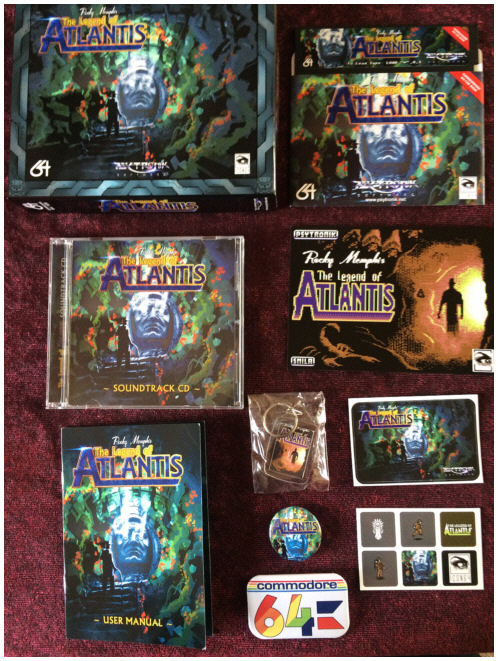
The contents of the Legend
of Atlantis Collector's Box
In this flick-screen adventure, legendary explorer Rocky Memphis is searching a forgotten tomb in North Africa for clues to the location of the lost city of Atlantis. Design and graphics are by Trevor Storey, coding by Stuart Collier and music by Saul Cross.
On each screen there can be a number of traps to overcome, ladders to climb and objects to explore. The player can carry multiple objects, with the inventory cycled through by Up and Fire. Down and Fire will search and Fire on its own uses the current object. Pressure pads can set off spikes, while deadly bats and scorpions will take away the explorer's lives. Stone tablets throughout the tomb will give clues, but the Book of Atlantis must be found first to translate them.
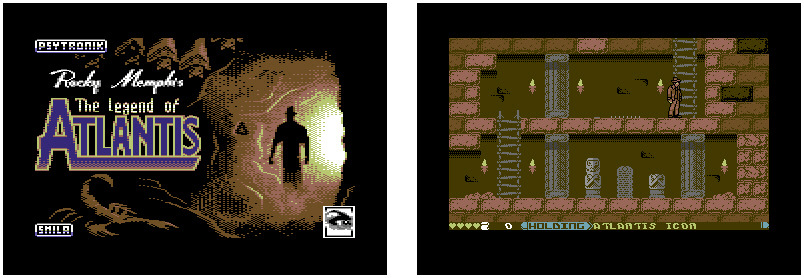
The excellent loading
screen, and the second room with some nasty spikes
The main sprite is really well animated, moving fluidly around the detailed high-resolution backgrounds. The great music adds to the atmosphere, with a few sound effects at key points (a "click" when a puzzle is solved, for example). It's a shame there is no save game function built-in and the random movement pattern of the enemies can make certain screens very tricky. But there is a lot of challenge in solving all the puzzles and getting the "good" ending.
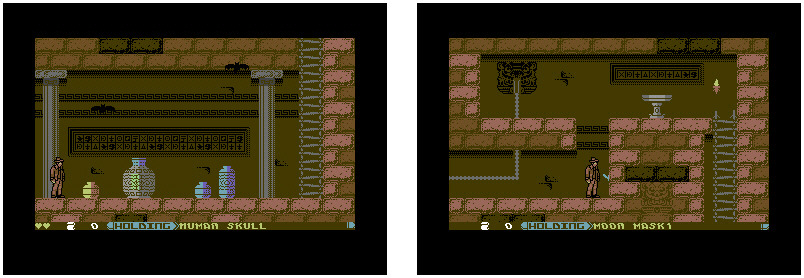
Watch out for the deadly
bats, and flip the switch to release something important
The Collector's Box is beautifully presented
and comes with a double-sided poster - one side is the box artwork, the
other a map of the tomb (but without spoiling what you have to do). All
formats come with a free digital download, which includes a picture file
of the map and a specially-named file for use on the C64 Mini. If you want
to live out your Indiana Jones fantasies, this is the game for you. And
yes, you do get a whip - in the game.
ORGANISM
- Digital download price $4.99
https://psytronik.itch.io/organism-c64
- Tape edition £6.99
- Budget disk edition £6.99
- Premium Plus disk edition £13.99
- Collector's box (with floppy disk, manual,
artwork stickers, a deluxe art card, badges, glossy game artwork poster
and a printed Heracles deck map) £39.99
http://www.binaryzone.org/retrostore/
(All physical prices with additional postage
& packaging according to location.)
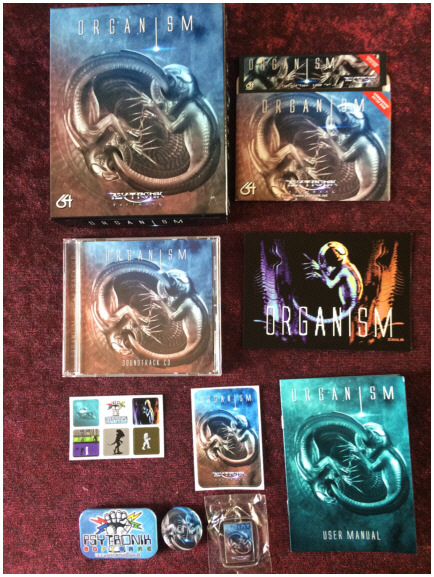
The Organism Collector's
Box is filled with goodies
Deep in space, something has gone wrong aboard the Heracles transport vessel. The last remaining crew member is woken from deep sleep and sets out to investigate what has happened to the rest of the crew. Trevor Storey was once again responsible for the design and graphics, Saul Cross did the music and Achim Volkers the programming.
The scrolling isometric levels contain doorways leading to other rooms, some of which are locked. The player must find passcards to open these locked doors. An onscreen scanner points to nearby objects of interest - members of the crew, the computer terminals and the data disks needed to access them. When a disk is inserted into a terminal, a puzzle game is played; the player must connect the coloured nodes with wires, but the wires cannot cross each other.
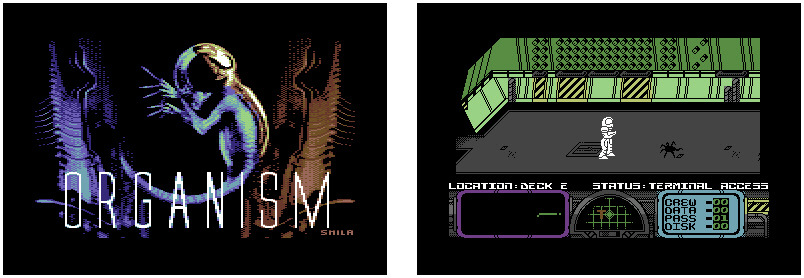
The loading screen, and
one of the small aliens you will encounter
Something else is moving around the decks. Swarms of small spider-like aliens run around and can be killed with a short burst of fire. When a missing crew member is found, there is another challenge for the player. Occasionally the player will find a room filled with alien eggs and must destroy them before they hatch. Deep in the ship there are many bipedal aliens to fight through too. Taking damage is shown by the heartrate increasing (with a trace drawing at the bottom of the screen), and when it gets too fast the player dies.
The backgrounds are very well drawn, making use of high-resolution mode for detail. Sprites are also in hi-res, giving the game a distinctive look. There is a very large ship to explore over multiple decks, with lifts used to travel between them. Like the Legend of Atlantis there is no built-in save option.
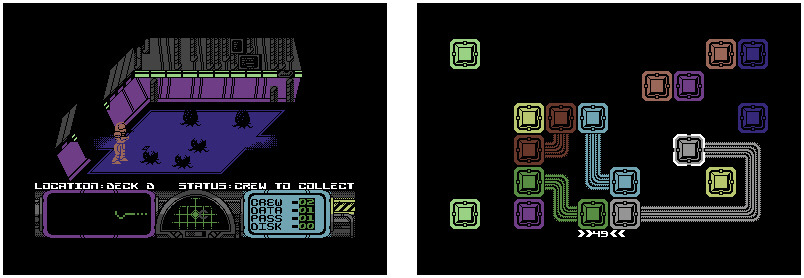
Destroy the eggs before
they hatch, and solve the puzzle to access a terminal
This game also comes in a fantastic Collector's Box edition. The double-sided poster shows the box artwork (drawn by Trevor) on one side and the deck map on the other. The digital download for this game also includes a C64 Mini file. This is another enjoyable release from Psytronik, but remember - in space no one can hear you get torn apart by aliens.
NOTE: the author paid for his review
copies of the games, and is not affiliated with THEC64 Mini or the company
behind it.
|
Back At It! I'm back after a one
issue hiatus. I had some family stuff come up in June and I think
that's why I missed the July issue. The family stuff is better now
though it's still something I'll have to deal with indefinitely.
However, as the issue deadline was coming, I wanted to put something together.
Typically, I'd do this in two columns, but I don't have a lot to say for
the Apple II this time, so this column will just be a combo one!
Apple II
I haven't been playing many old Apple II games recently. But in following A2 Central (http://www.a2central.com), I saw an announcement of a new game called OidZone, a remake of Asteroids. The game looks fun, too bad I don't have a working Apple II but it's great that there is still some active development for the Apple II computers.

Check out the website for more information and to order the game: http://www.berighteous.com/
Also worth noting is that the last remaining Apple II PRINT publication, Juiced.GS is set to publish in 2019 (its 24th year!).
To put that into context, when Juiced.GS started in 1996, the Apple II computer line was effectively dead. While there was still an active user base, most of the commercial magazines such as A+, Incider (later combined as Incider / A+) and II Alive all died off. Yet, Juiced.GS has persisted and evolved to the point where the magazine will keep going as long as there are interesting topics to discuss.
If you're interested in subscribing, please
go here: https://juiced.gs/
Nintendo Switch - Punch Out!!
So with my family situation occurring, I found myself spending a lot of time sitting around at various places without a computer. I was usually stuck with a phone which I spent a lot of time reading articles, comics, or whatever came to mind.
However, since I did have a Nintendo Switch, I brought it along to play some games. I went with my suite of FIFA 18, RBI Baseball 17 and Tetris. But playing those games over and over got boring so I started looking for other games to play. i wasn't interested in any long play games - Doom, Wolfenstein, etc. That left me looking at some of the old Nintendo Arcade Archives games. While I had a few choices, I finally settled on Punch-Out. I had fun playing Punch-Out at the High Scores Arcade in Alameda, but having it on the Switch would be interesting.
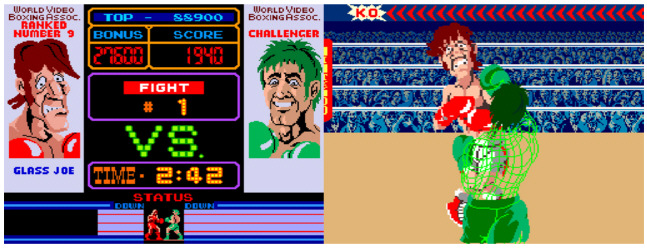
While this isn't necessarily a full review,
it was a lot different playing Punch-Out on the Switch versus the full
sized arcade machine. The Switch version (which is download only)
tries to replicate the two screen look of the arcade machine. However
the setup looks weird when playing the Switch off the dock. When
playing on the TV it looks better but not quite as good as the arcade version.
The gameplay was reasonable and there are actually a couple of different
modes you can try. For $7.99, it's good for a few hours of entertainment
though it can get repetitive after a while. Personally, I'm still
hoping for Warner Bros. to release Midway Arcade Classics for the Switch!
|
While it seems that the experience many have with obscure arcade games is due to the mass proliferation of MAME, the Multiple Arcade Machine Emulator, I first played most of the lesser-known titles I enjoy on actual hardware. Two of these games, DJ Boy and Sly Spy, were located in an independently owned pizza parlor in the central valley. Papa Jim's, as it was called, was a bit of a dive but became a regular outing every week or so. Having just relocated from the Bay Area and in the process of closing on a home, visits there were a spot of regularity in the midst of a temporary arrangement.
Released in 1989 by Data East, Sly Spy is more or less an unlicensed James Bond run and gun, very similar to their RoboCop arcade game from 1988 and Namco's Rolling Thunder from 1986. Rather than taking place in Europe as most James Bond adventures do, Sly Spy is set in the USA sometime in the 1990's. The CWD (Council for World Domination) has presumably killed the President, using jetpack-wearing operatives no less. Secret Agent (which is actually the Japanese title of the game) Sly is tasked with tracking down CWD and preventing a nuclear attack.

Sly dives into action
(left), the first boss battle is visually striking (center), Sly gives
chase on his motorcycle (right)
True to its secret agent theme, the first thing a player does is enter a three digit agent number. Of course most people would enter 0-0-7 and the agent number is also used in place of initials on the high score screen at the game's conclusion. Sly Spy opens with one of the most unique and memorable first stages in run and gun history. Sly jumps from an aircraft and skydives toward Washington D.C., having a mid-air shootout with CWD henchmen as the capital grows closer and closer in the background. After dispatching the aerial threat, Sly opens his parachute, featuring an American flag design similar to Bond's Union Jack parachute as seen in the opening of The Spy Who Loved Me. Even though this opening scene is rather short, there's good detail in both the background and sprite work. Sly wears protective eyewear as he plummets toward the ground, and his clothing flails in the draft.
Once reaching the ground the game truly begins, settling into a more conventional run and gun pace. As stated earlier, Sly Spy owes a debt to Namco's Rolling Thunder. Sly can move forward and backward, jump and duck, as well as shoot. Ammunition is limited but bullet pickups left behind by enemies are frequent, and I've never completely run out of standard ammunition while playing. One thing that becomes very clear right from the beginning of this stage is that Sly Spy throws a ton of enemies at the player - an almost ridiculous amount of enemies. Success in this game depends as much on methodically moving forward and dispatching foes efficiently as it does quickly reacting and avoiding fire. The first boss battle is actually against a wave of henchmen who rappel from the ceiling in front of the Lincoln Memorial. This type of boss battle will occur a couple times throughout the game and the key is to predict where enemies will drop and defeat them as quickly as possible.
The next stage mixes things up with an enemy pursuit while riding a motorcycle, armed with a forward facing gun like something from Q Branch, and very much lifted from Never Say Never Again. Sly can move forward and back a little here, duck, as well as jump and pop a wheelie to angle his gun upward. Enemies consist of motorcycle riding henchmen and others with jetpacks providing aerial fire. While an interesting concept, this stage ultimately falls a little short. With the limited area of movement there really isn't a lot to do other than duck under shots and pick off enemies as quick as possible. The boss battle at the end is against a fleeing sedan, equipped with a couple of henchmen and a boss with what looks like a rocket launcher. As with the rest of the enemies, the strategy here is to duck under their fire, shoot once they're open, rinse and repeat. While it would make sense to fire rapidly once a boss is open, it doesn't work like that with most bosses in Sly Spy. After being hit, a boss will generally have a few moments of invulnerability while they are stunned from the impact. This places more emphasis on understanding and adapting to boss patterns rather than mashing the fire button constantly.

"His name's Jaws, he
kills people" (left), underwater with the Golden Gun assembled (center),
Sly swings across a gap (right)
Sly pulls up to the next area in his Ferrari F40 but the entire stage takes place on foot. This is the first stage that plays out in a purely conventional fashion with no enhanced gimmicks, once again leaning heavily on the concepts of Rolling Thunder. The majority of the stage features both a high and low path but only a couple opportunities to change between them. Sly Spy finally goes full James Bond at the end of this stage, as the boss is clearly based on fan-favorite henchman Jaws from the films The Spy Who Loved Me and Moonraker. This time around his arms have been armored in addition to his steel teeth, providing him with means for defensive cover. Sly can shoot Jaws from a distance but if he gets too close Jaws will disarm him and force a hand-to-hand fight. Seeing Jaws for the first time here adds a bit of extra charm to the game but the battle itself is very simple and Jaws goes down without much trouble.
Playing into another James Bond convention, the next stage takes place underwater and Sly's pistol has been replaced with a harpoon gun. Swimming movement is thankfully very smooth and aside from being underwater the stage plays in a standard manner. Many of the henchmen here will be holding onto Diver Propulsion Vehicles, or DPVs, that they will drop once defeated. Sly can then grab the stray DPV for increased movement speed in all directions. At this point the player will probably obtain the Golden Gun for the first time, obtained by collecting enough "G" icons to fill in the silhouette of the titular weapon in the upper right corner of the screen. The Golden Gun functions much like the Cobra gun from Data East's RoboCop arcade game, allowing powerful single-shot kills for a limited amount of time. This type of "build it as you go" ultimate weapon was actually first seen in another Data East game, Heavy Barrel from 1987. While the Golden Gun is a fun addition, it is only made available for an extremely short duration once completed and doesn't add much strategy to the gameplay. Two bosses await Sly at the conclusion of the stage, the first a diver in a mechanized deep diving suit. Easily the lamest boss in the entire game, he can be dispatched by lining Sly up to shoot his helmet while just above the reach of his claw. The second boss is a large shark that swims back and forth across the screen, requiring patience and quick movements to hit with a shot during each of his passes.
The next stage puts Sly back on dry ground and is once again a conventional area with a high and low path. Booby traps such as spikes, crushers and conveyor belts come into play, adding some variety. Things conclude with a boss battle against a series of tigers, similar to the rappelling henchmen from the end of the first stage. There's a bit of hidden depth here as if Sly shoots a tiger it will back down and then lunge forward, requiring another shot to put it down. However if Sly exhausts his bullet supply prior to the battle, he will fight the tigers with his bare hands. A melee attack against a tiger will take it out with a single hit and no repercussion of being pounced on. The next stage continues on foot with a descent into the weapons storage area. Unfortunately there can be a lot of cheap damage in this stage, as the majority of it is made up of blindly dropping down onto enemies or into their line of fire. Once reaching the bottom there's a visually striking underground submarine bay and the opportunity to steal an enemy's jetpack, adding a little more variety. Oddjob, the hat throwing henchman from Goldfinger, awaits Sly at the end of the stage and utilizes his trademark attack. Unfortunately as with all the bosses in Sly Spy, he is easy to defeat. Simply duck under his hat and fire while he waits for it to return to him.

Bypassing enemies with
a jetpack (left), the very much in theme continue screen (center), Oddjob
attacks (right)
It's at this point that regardless of all the variety Sly Spy attempts to offer, the game begins to feel shallower than it should. The next stage takes place underwater once again but adds nothing to what was featured the first time. In fact it ends with the exact same diver boss again, this time without the shark following him, making the whole stage feel pretty empty. Unfortunately this uninspired swimming stage is the lead up to the final stage in the game. In a bit of self-aware Data East humor, the final stage begins with RoboCop lying beheaded on the ground. Then again, I guess it's no worse than what Frank Miller did to the character with the ridiculous film sequels. Although reasonably short, the final stage ramps up the enemy encounters to an insane degree, essentially throwing everything at Sly. If nearly every minor enemy in the game wasn't enough, the stage concludes with a long climb up the nuclear missile silo, repeating nearly every previous boss encounter along the way. The final boss is rather boring, as he simply stands behind an energy wall while a ceiling of spikes slowly lowers toward Sly. Rapidly attacking the energy wall will cause it to disappear, allowing Sly to attack the leader of the CWD, who goes down with a single hit. Now that's about as anticlimactic as they come!
Sly Spy charges out of the gate as a loving homage to the Bond films with bright colors, detailed graphics, and good variety. Yet it burns itself out after the first few stages, as if the developers ran out of ideas or more realistically ran out of time. Music is composed of general spy motifs, including an intro taken right out of the James Bond Theme. The bit of speech in the game is nothing special, although I've always liked the "Ooooh, Spy!" clip that plays when the high score screen is displayed at the conclusion of a game. The background of the high score screen is another Bond lift, this time a pretty blatant copy of the teaser poster for The Living Daylights - one of my personal favorite Bond films. The continue screen is reasonably stylized, with the nuclear missile beginning to launch, and the countdown being reset once the game is coined up again.
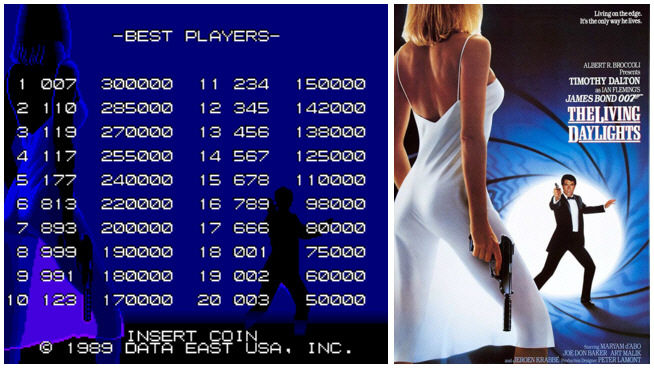
An homage or a totally
unlicensed lift?
Ultimately the variety in Sly Spy isn't
really utilized well enough, with short stages and interesting ideas that
are quickly dropped for the game's next gimmick. It almost seems
at one point during development there was an intention to include a driving
stage in Sly's Ferrari F40. However this vehicle is only used as
a stage introduction a couple of times. One thing that is well utilized
is Data East's love of self promotion. There are posters for Chelnov
and Karnov that can be seen hanging in the background of a couple stages,
as well as a series of billboards advertising Bad Dudes. The
game itself is rather short, less than ten stages, none of which take all
that long to complete. In fact a standard play through will take
less than twenty minutes, even for someone unfamiliar with the game.
Sure, it's an arcade run and gun, a genre that doesn't always equate to
long play times but there really should be more on offer here. Even
extending the stages a little would go a long way to help make the game
feel like a heftier adventure. That said, I've always had a soft
spot for this game and even though it's rather short, I recommend it to
those who enjoy games like Rolling Thunder or fans of the Bond films.
Most of Sly Spy's shortcomings would be addressed one year later with the
absolutely insane The Cliffhanger: Edward Randy, Data East's homage to
Indiana Jones, an even more obscure arcade game we'll look at in a future
issue.
|
After Sega stopped producing the Dreamcast console in 2001, professional game journalists decided to backlash the company, as some kind of collective vendetta. Suddenly, everything Sega created was crap. We, the consumers, believed these journalists. But in 2005, Sega did something so great that even its haters couldn't object to: the first Yakuza game was released. A spiritual successor to both Shenmue and Streets of Rage, the game spawned a series that endures to this day.
I was in college when Yakuza was released. My Master System halcyon days were long gone. The console itself resting peacefully in some dusty shelf. But then I read about Sega's new release on EGM Brasil. The text and the pictures fascinated me: everything looked so close to the Shenmue I played at my best friend's house for months and better yet, everything looked so Sega-ish about that game, that I decided to buy it.
And it really was an amazing game! I played it for weeks, the game was everything a Sega fan could have hoped for. It made me think, "these journalists are lying about Sega, the studio still delivers... I'm going to search the Internet about their new releases." Enter the world of the magic World Wide Web: being already a reader of Retrogaming Times Monthly, I decided to check on the newsletter's authors and found David's Video Game Insanity. On this website, I found what is maybe the ONLY positive review in the world for the Sega Classics Collection, a PlayStation 2 compilation of low-budget remakes of Sega arcade games.
"This David guy seems legit. I'm gonna try the collection." And so I did. And, again, I was amazed by the fact that the compilation wasn't as bad as everybody was saying. Yeah, there was that slow Golden Axe remake among the games, but the compilation was deeply enjoyable. Besides, compilations have a strange power, they make us desire to go back in time and start collecting for our favorite consoles again.
Off with the dust. On with the cartridges. My Master System was back in action. Soon my collection would grow beyond what could fit in my room. But of course, collectors are never satisfied. I went after the new releases. The VCS had them, the NES had them, the Sega Genesis had them, why not the Master System? Because the SMS didn't sell as well as the other consoles mentioned, that's why.
But even without new cartridges (besides Digger Chan), there is a homebrew community producing for the Genesis' older brother. Most are European and Brazilian folks who are members of SMS Power!, a legendary website by Omar Cornut, the creator of Wonder Boy - The Dragon's Trap remake, one of 2017's best games. My favorite homebrew creations are KunKun & KokoKun, Bruce Lee and Waimanu - Scary Monsters Saga. Of course there are others I enjoy, including Waimanu's sequel, Weka Invaders, and lots of minigames by haroldoop (try NanoWars), but let's focus on the three I've spent more time with.

KunKun & KokoKun
(Omar Cornut)
KunKun & KokoKun is a cute puzzle game developed by the same Omar Cornut mentioned before, the father of SMS Power! and also the guy responsible for preserving many rare Sega 8-bit games as ROM dumps. KunKun must save his beloved princess KokoKun from her captor, who doesn't appear in the game, avoiding many hazards and traps. This one reminds me of Chack'n Pop and vintage DOS shareware, where the controls are as simple as using only the directional and an action button. The only downside is the lack of sound, which isn't a huge problem, given the nature of the game: a very replayable brainteaser.

Bruce Lee (Kagesan)
While KunKun is an original game, Bruce Lee is a remake of the Atari 8-bit and Commodore 64 classic. Neither of these computers were ever released in Brazil, where the British ZX Spectrum and the Japanese MSX were far more popular. So, the first time I played this game was thanks to this marvelous SMS homebrew conversion. From the looks to the sounds, everything makes the game close to what a Bruce Lee conversion might have been back in the 80's. Kagesan, its programmer, really grabbed the Master System spirit.

Waimanu - Scary Monsters
Saga (Disjointed Studio)
Waimanu - Scary Monsters Saga (SMS, got it?) fills one of the Master System gaps: the console didn't receive a Pengo version during its shelf lifetime. Made by the Italian Disjointed Studio, this one amazes its players with the complete package. Good graphics, nice music, a cute penguin, selectable difficulty, aliens and special powers to kill them. They didn't forget anything. Even the pause is well done, with a picture of the penguin greeting us. The sequel, shoot 'em up Weka Invaders, has even better music and promises a third game to end the trilogy. I'm anxiously waiting for it.
These homebrew, and lots more, are available
through the Homebrew section of SMS Power! (http://www.smspower.org/Homebrew/Index).
Although the SMS community is still a small one, its size makes it mightier,
since everybody exchanges information and experiences. Like I wrote in
another of my articles, the day we'll be able to buy new Master System
cartridges isn't far. Even CollectorVision is preparing something Sydney
Hunter related. And when it does, I'll be there, enjoying it and hopefully
writing a review to this newsletter of ours.
|
There are literally dozens of choices for anyone wanting a system to emulate classic games. From stand alone systems like the Atari Flashback and Mini NES to modded Xboxes to a huge variety of Raspberry Pi systems. So why would someone want to throw their hat into such a crowded market? That is a question most of us had to ask when the Dreamcade Replay was first crowdfunded over a year ago. The one difference the Replay has is a unique front end that has been tested for years on standalone arcade machines. But would it be enough to make it stand out?
The first thing to point out is the Dreamcade Replay has changed a lot from what was originally shown on Kickstarter. The most noticeable difference is the look. Gone is the Atari 2600 mini look it had, and instead it has a very generic looking cube. A big reason for this was Atari pulling out of it to make their own Atari VCS. Gone with the design was also the Atari Vault games that were supposed to ship with it. So instead of getting a dozen Atari classic arcade games and a bunch of Atari 2600 games, most of which are forgettable (does anyone really want to play 3D Tic Tac Toe, Basic Math and Race?), you get one hundred even more forgettable titles. When one of the highlights of the games included is Super Noah's Ark, you know they are scraping the bottom of the barrel to fulfill their obligation.
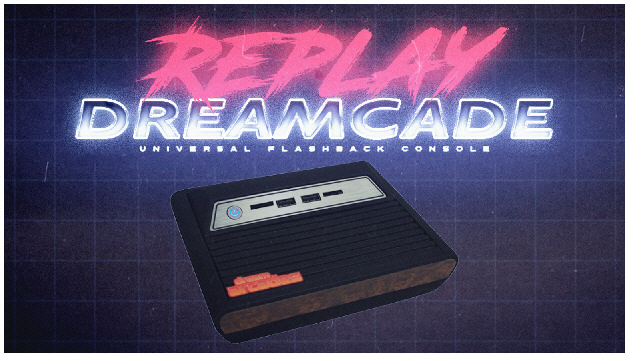
Dreamcade Replay as it
was announced and funded
Not all the changes were negative. There were a few changes that improved the Replay. The first was a better processor. The new Apollo Lake processor beefed it up and made it possible to support some emulators that we did not expect to be supported like Sega Dreamcast, Sony PSP and Nintendo Gamecube. While these systems are not completely supported, a good number of games do work. And this was a welcome surprise. From a system that was supposed to max out with the Sony PlayStation and Nintendo 64, to now support three more modern systems was exciting.
When talking about the Dreamcade Replay, I must mention the big advantage it has over the Raspberry Pis and ODROIDs and that is the Retro Reload game search. What this feature does is allow you to put in the name of just about any game and have it search the web for a ROM file to download. You can then click on it and it will download and put it in the proper folder. Within a minute, you can be playing the game. It takes one of the most taxing parts of emulation and makes it a breeze. Sure you can buy a system with thousands of games already loaded (ebay has tons of these up there), but if you are leery of this and are fearful of downloading ROMs for fear of viruses, this is a dream come true. For the most part, it works really well. You can just type in Pac-Man and get the top 40 or so choices. Or you can narrow it down and look for Pac-Man on Atari 2600. It really is that simple. One thing to keep in mind is this is still in development. It needs some fine tuning to work properly. To start with it does not support looking for PlayStation games. Nintendo 64 is the newest you will find. And the support for classic computers is very limited. I put "Star" in the search for Commodore 64 and got about four choices. There were at least twice as many just for Star Wars and Star Trek games alone. Forbidden Forest and Space Taxi were absent from later searches, even when I put the entire name in it. But for classic consoles, it worked quite well.
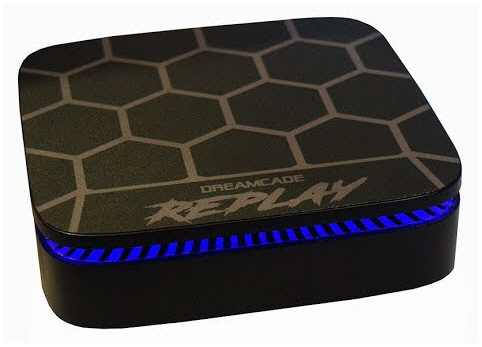
Dreamcade Replay as it
was realized and shipped
Another big selling point was that it supports a bunch of systems right out of the box. For the most part that is true. It does come with most of the emulators already installed. Most do not show up on the frontend until you add a rom from that machine, but they are there. Here is a quick list of most of the systems that are supported out of the box - MAME, Atari 2600, Atari 5200, Atari 7800, Atari Lynx, Atari Jaguar, ColecoVision, Intellivision, Vectrex, Bally Astrocade, Odyssey 2, Fairchild Channel F, NES, Super NES, Nintendo 64, Game Boy, Game Boy Color, Game Boy Advance, Virtual Boy, Gamecube, PlayStation, Sony PSP, Sega Master System, Sega Genesis, Sega Game Gear, Sega Dreamcast, Turbografx-16, Commodore 64, Apple II and a few other classic computers. As you can see, there is a good selection of emulators and most work quite well. Keep in mind some will require a keyboard to play (all the computer ones, ColecoVision, Intellivision and Odyssey 2). Also not all emulators work well with every game. Some may have sound issues or tearing. But overall, I found the older systems generally work great. When you get to the later systems, it is really hit or miss. The PSP works really well, while most of the Gamecube and Dreamcast games have issues, if they work at all. But overall it is a very positive experience.
Since the Replay is just a mini Windows 10 computer, you can also install your own emulators as well as watch Netflix and Hulu and surf the internet. They are trying to be a do everything little box and for the most part they succeed. And for the starting price of $99.00 (this was the kickstarter price for the console with no controller), it is a very good deal. You do get a lot of computer power for a very low price.
One area where they really fell short was with the controller. If you chose to include a controller (like I did), then you ended up with a very cheap controller. While it works fine for the most part, it looks and feels cheap. I saw the same controller at Walmart for $12.00 minus the Replay branding. They sell it for $30.00. The good thing is you can pretty much add any controller you want and for the most part it works but I have come across problems with controllers. For one thing, I found that I had to reprogram the controls into certain emulators over and over. If you are looking for an out of the box experience with little or no problem, this may not be for you. They are updating it and I hope to see it improved in the future as well as add more emulators (would love to see some classic computers like Atari 8 Bit and TI 99/4A as well as some other systems like Nintendo DS and 3DO).
Overall, I do recommend the Dreamcade Replay. For the price, you are getting a nice little system that does make emulation easier. It has a frontend that is easy to navigate with enough customization for people to make it their own. The emulators for the most part work well and they make finding games a breeze. They even offer an option to take pictures of your carts and have them loaded into your system, but with the search feature, I really don't see the need for it. It is well worth the money and for the most part, it does what it promises. Does it have issues? Yes it does. But they do seem intent on fixing those and none of them are dealbreakers.
To be honest, if you have more money to
spend, I think you would be better off with the Shield TV. It supports
as many systems, if not more and you have a bunch of Android games to play
as well. Granted it costs twice as much, but you are getting a much
better system. But if you are on a budget, Dreamcade Replay is probably
the best affordable option out there. And if you do not have a ton
of ROMs or are hesitant to randomly downloading ROMs from less than reputable
sites, than the Dreamcade Replay is for you. Within minutes, you
can find, download and play just about any classic game. And you
will be hard pressed to find a system that makes it any easier than that.
|
This is a follow up to my previous article
"A History of Pac-Games on the Atari 2600" from the previous issue.
This time I will be looking at the Pac-Man games that were released for
the Atari 5200 during its commercial life, homebrew releases, and two unreleased
prototypes. The latter two will be reviewed in more detail.
Commercial Releases
The Atari 5200 only had two Pac-Man titles during its commercial life. These titles were Pac-Man and Ms. Pac-Man. The former was a far better adaptation than what Atari created for the Atari 2600, thanks to the greater power of the Atari 5200; while the latter was an even better adaptation of the arcade game. Let's look at these games more closely.
Pac-Man
Pac-Man makes a spectacular appearance on the Atari 5200. This port of the game captures every element of the arcade rather well. The maze is just like in the arcade, though stretched to fit the horizontal TV screen. This stretching actually gives this version more dots for Pac-Man to eat than in the arcade version. The game is also faster than the arcade from the outset, which makes it more of a challenge for players.
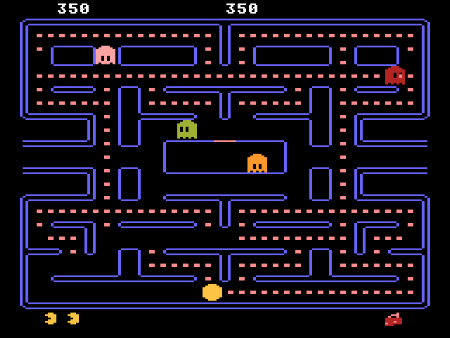
Pac-Man (Atari)
All the intermissions, bonus fruits/items and arcade sound are included in this version. If there is one thing the game could be faulted for it is the ghosts. For some reason, they are of a solid color and have no detailed eyes. The eye sockets are just hollow and it is a shame because I'm sure they could have had eyes just like in the arcade. These hollow eyes do move up, down, and sideways depending on the direction the ghosts are going, though, which is a nice detail. Pac-Man has a one or two player option and allows you to choose your starting level. Truly an excellent game for the system.
Ms. Pac-Man
The 5200 version of Ms. Pac-Man is superb and it surpasses what Atari did with Pac-Man. The four mazes are included here, like in the arcade, and they have been stretched some because of the vertical aspect ratio of TVs but they are not as stretched as in Pac-Man. The colors of the walls are similar but not identical to their arcade counterparts and the dots do have different colors for each maze. The fruits/items are here as well and they move about the maze as they are supposed to. Sound effects are nicely emulated as well and are a close match to the original arcade sounds.
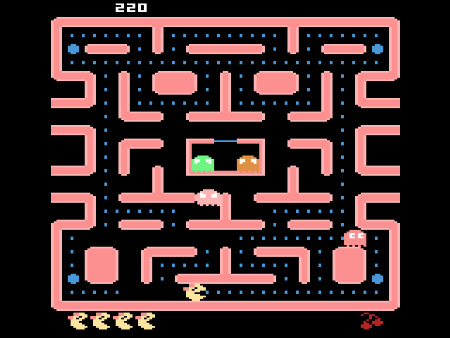
Ms. Pac-Man (Atari)
Ms. Pac-Man looks great with her bow and
the ghosts even have their full yes this time around (unlike the empty
sockets seen in Pac-Man). Their behavior is similar to that of their arcade
counterparts, which is an important element of the gameplay. Though this
game is slower than Pac-Man, this change works well as the game control
functions properly with the 5200 joysticks. Overall, this is one
excellent port of the Lady of the Pac.
Homebrew Releases
The 5200 is not without homebrew programmer support and it has had a couple of titles released that belong to the Pac-Man family: Pac-Man Arcade and Hangly Man Plus. The former looks to improve what Atari did while the later is a hack that adds "Plus" features and new mazes to Pac-Man. Let's look at these.
Pac-Man Arcade
So, you are probably wondering why would anyone develop another version of Pac-Man for the Atari 5200 since it already has a great port. Well, as good as the original Atari port of Pac-Man is for the 5200, this new adaptation actually takes that up several notches making it not just a great port but a perfect port of Pac-Man.
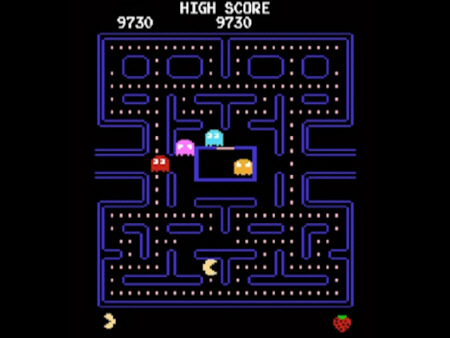
Pac-Man Arcade (tep392)
In this new version for the 5200, programmed by Atari Age member tep392, there is now a real title screen and introduction screen for all the ghosts and Pac-Man. The maze has been adjusted so it is not as stretched as it was on the Atari port and the walls have a wider edge. The ghosts now have eyes and their movements match those of the arcade ghosts to perfection (Blinky will target Pac-Man's current location while the other ghosts target locations based on direction and distance) and game sounds are now a near-identical match to the arcade.
The vertical passages above and below the ghost pen don't allow the ghosts to move up, which is something you can use strategically when playing. Of course, all the intermissions are here as well as the bonus items. The number of dots in the maze is correct and this time the ghosts do have eyes! A one or two-player option is available and you are able to select your starting level. If you want an arcade-perfect Pac-Man for your 5200, look no further!
Hangly Man Plus
Hangly Man Plus, programmed by Bob DeCrescenzo, is a clone of yet another clone, Pac-Man Plus. In Hangly Man Plus you play Hangly Man, a character that is yellow and round very much like Pac-Man, who has to clear the dots in a maze. He is chased by four ghosts who want to stop him from clearing up the maze: Oikake (nicknamed Akabei), Machibuse (nicknamed Pinky), Kimagure (nicknamed Aosuke), and Otoboke (nicknamed Guzuta). Hangly Man can turn the tide against the ghosts by eating the one of the four power pellets at the corners of the maze and this is where things get interesting.
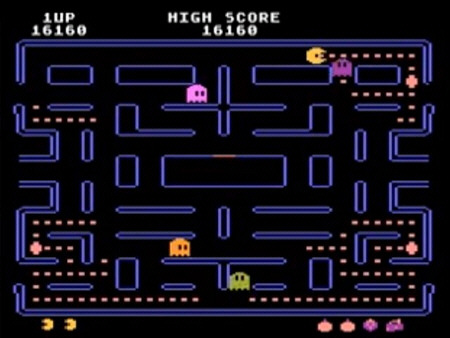
Hangly Man Plus (Bob
DeCrescenzo)
Unlike what happens in Pac-Man, not all
the ghosts may turn blue and run away when Hangly eats a power pellet,
so he may end up getting killed if he is being closely chased by a ghost.
To add more spice, the bonus items that appear in the middle of the screen
also make the ghosts edible to Hangly Man but they also become invisible.
Mazes are not consistent either. A maze may just be a variation of the
Pac-Man maze or there may be no maze at all as the dots are arranged inside
just the borders along with the ghost cage. If Hangly Man has eaten the
four ghosts after a power pellet, the next power pellet will make the maze
black temporarily. There is enough variation to make this game feel fresh.
The graphics and sounds are very similar to the Pac-Man port for the system
and it plays just as fast.
Prototypes
Two prototype games are known to exist for the Atari 5200: Jr. Pac-Man and Super Pac-Man. Neither game was released commercially but their binaries have been discovered and can be obtained to play both games. Both of these games are pretty much finished but with Atari's purchase by the Tramiels, they were shelved.
Jr. Pac-Man
So, after the very successful Pac-Man and Ms. Pac-Man games, what else could be done with this formula of dot gobbling characters? How about horizontally stretching the mazes so that they scroll as the player reaches the right or left edge, adding more power pellets, adding exploding bonus items, removing tunnels from the sides of the mazes and using the kid of Pac-Man and Ms. Pac-Man as the main character? In Jr. Pac-Man, Jr. is the star of the show. He wears a propeller beanie as he moves about the mazes eating dots until they are clear.
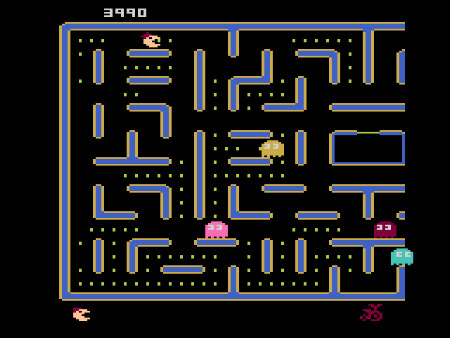
Jr. Pac-Man (Atari, unreleased)
Of course, the ghosts are back to chase after Jr. but, in this case, the level of energy is higher so the game is much faster than before. Bonus items in Jr. Pac-Man are toys that move about the maze but they do two things bonus items didn't do before: enlarge any dots they move over and blow up any power pellet they happen to stop at. If Jr. moves over the enlarged dots, he moves slower but he racks more points. The game has a total of seven mazes to challenge the player and, believe me, challenged you will be.
The 5200 version of Jr. Pac-Man is excellent and this should come as no surprise as it was programmed by the team from General Computer Corp. (GCC). The graphics have the same style as that of Ms. Pac-Man and all the sounds from the arcade are here. The only thing missing from this version is the set of intermissions we have come to expect in Pac-Man games. It is likely there wasn't enough ROM space left to include them. Despite this omission, the game is a superb adaptation of the arcade game and well worth playing. It is unfortunate that the Tramiels chose not to release this title for the console, particularly since it was already finished. Thankfully, the binary can be found online and enjoyed today.
Super Pac-Man
It's a bird! It's a plane! No, it's Super Pac-Man! In this version of Pac-Man, the original titular character makes an appearance again but with a very different formula. Gone are the dots from the maze and instead there are fruits and other items locked in boxes spread in a maze (in fact, the boxes make the maze). Pac-Man must go around the maze eating keys that unlock these boxes so that he can then eat the items in them. Early on the keys open boxes that are close to them but, as the game advances, the keys open doors further away.
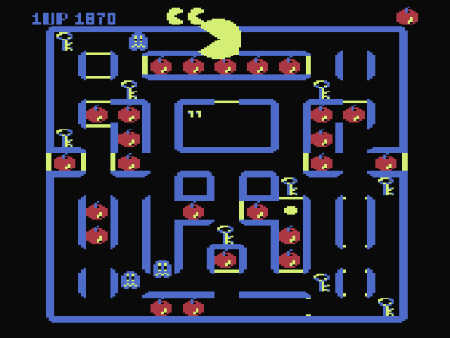
Super Pac-Man (Atari,
unreleased)
As in the original game, there are power pellets in the maze (also locked away) so that Pac-Man can eat the ghosts. However there are also special power pellets (super pellets?) that turn Pac-Man into Super Pac-Man. This temporarily gives him the ability to become impervious to the ghosts (they flatten out) and to eat through the doors so he doesn't need keys to get to the fruits and other items in the boxes. Pac-Man can remain in his super state if he eats a regular power pellet before turning back to his normal self, which then also gives him the ability to eat the ghosts. A bonus star appears in between two boxes in the middle of the maze, its value varying according to the items within the boxes when eaten.
Super Pac-Man for the 5200 was developed
for Atari by Landon Dyer (Programmer), Gary Johnson (Graphics), and Brad
Fuller (Audio). This port is truly well made and is as close to the
arcade original as it can be. The maze is stretched somewhat to fit the
TV screen but it is arcade accurate and the ghosts are rendered better
than in other Pac-titles for the system. Their eyes have both white and
black parts to them and look in the direction the ghosts are moving.
Too bad this was another unfortunate victims of the Tramiels but, like
Jr. Pac-Man, it's binary can also be found online for your enjoyment.
Concluding Remarks
The Atari 5200 has a good library of Pac-Man
games, all of which were well made from the outset. True that homebrew
development has allowed for an even more accurate version of the original
Pac-Man, but it is clear that Atari knew they couldn't mess up when it
came to releasing these games on the 5200. Thanks to the console's
POKEY sound chip, not only did these games look great, but they are sounded
great as well. It is unfortunate, however, that games like Jr. Pac-Man
and Super Pac-Man were never released during the console's commercial life.
It is fortunate, though, that the binaries for the games were discovered
and shared with the community for the enjoyment of all.
|
Twenty-two years ago a group of arcade collectors and enthusiasts came together to host the first California Extreme arcade game and pinball show. The event has continued to grow every year and for 2018 it was once again hosted at the Hyatt Regency, Santa Clara. Located in the heart of Silicon Valley, California Extreme has always been true to its roots as a celebration of the arcade era and arcade gaming. Where arcade gaming has been, where it is now, where it is going, and a wonderful opportunity for game owners to share their collections with each other and general attendees. A modest entry fee grants access to the show, which stretches over two days - Saturday 11am to 2am the next morning and Sunday 11am to 9pm. In addition to a show badge and lanyard, pre-registration also allows entry into the convention ballrooms a full hour before general entry begins. All games at the show are free play, meaning the single entry fee is good for two full days of arcade gaming and pinball action.

Looking out at roughly
one-quarter of the main ballroom at California Extreme 2018
2018 saw the continuation of utilizing an additional ballroom that began last year. In addition to the massive main expo ballroom, the smaller (yet still very large) ballroom featured even more games and the ever-present collection of cocktail tables and smaller cabaret cabinets. Additionally a separate event space is used for panels and seminars. There's also a free console gaming area that featured live music on Saturday night, and yet another ballroom hosted the annual pinball tournaments. Various vendors selling arcade parts, pinball supplies, console games, crafts, shirts, books, and other gaming related merchandise could be found in any of the three gaming ballrooms. This was my eleventh consecutive year in attendance, and nearly as many years covering the event for a Retrogaming Times newsletter. Rather than concentrate on a few specific classics or a general show perspective, I thought I would instead focus on a few games that were publicly exhibited for the first time at California Extreme 2018.
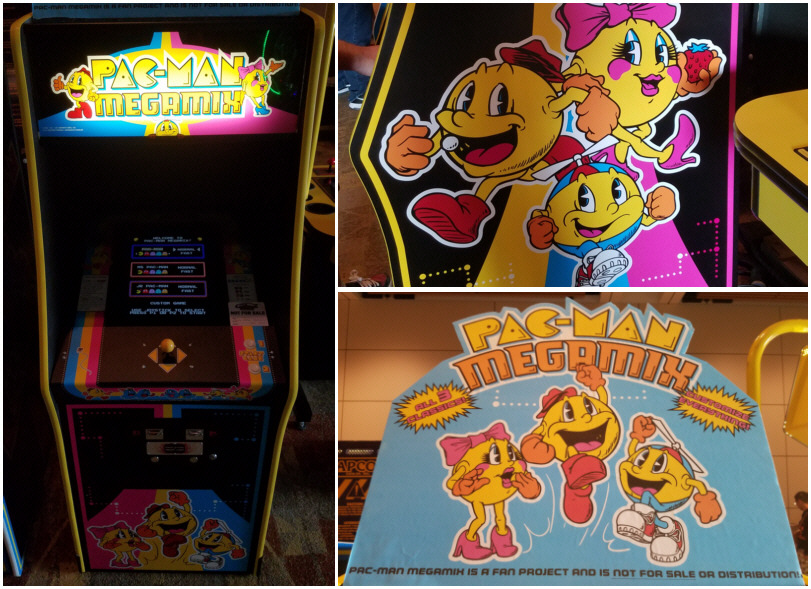
Pac-Man Megamix is a
fan project that is a 100% home made celebration of the three classic "Pac
Family" games
Right at the entrance to the secondary ballroom sat one of the new games I was most looking forward to trying, Pac-Man Megamix. Created by Dustin Friend and Brendon Parker as a one-off not for sale fan project, Pac-Man Megamix not only includes normal and fast versions of Pac-Man, Ms. Pac-Man, and Jr. Pac-Man but also the new "Custom Game" feature. Custom Game is just that, a fully customizable Pac game built upon assets from the three included titles. The game mode, maze set, player character, fruit set, ghost AI, starting lives, and visual style can all be configured. Additionally the player's speed can be set to different rates or even customized to an exact specific number. This goes the same for the ghost speed, which is customized separately. Starting stage can also be chosen, as well as including a fifth ghost, Sue, to mix things up further. The visual style option has three settings: the classic game graphics, a slicker HD type version of the classic graphics, and finally modern graphics more in line with Pac-Man Arrangement as was seen in Namco Classic Collection Volume 2. Incredibly the visual style option can also be configured on the fly by pressing the player start button while in game, cycling through the three different modes.
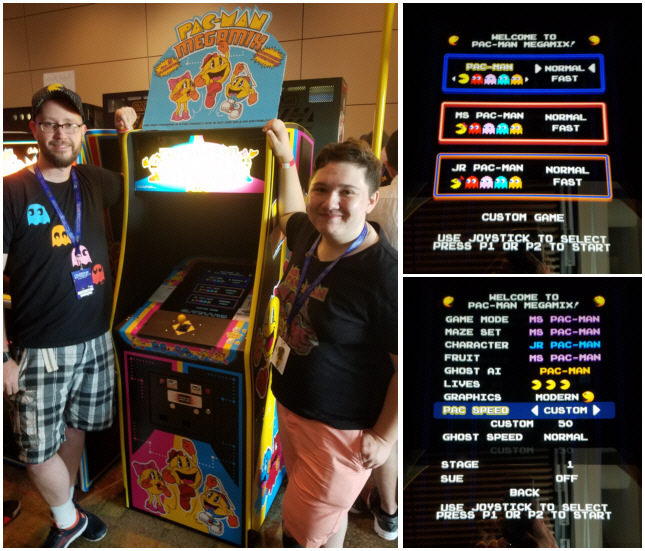
Dustin Friend and Brendon
Parker with their collaborative creation (left)
Game selection menu (upper
right), options selections for a Custom Game (lower right)
As an example of a Custom Game, you can set up the game mode to be Ms. Pac-Man (which will follow the stage and intermission screen progression of that game, as well as the fruit characteristics), the maze set to be Ms. Pac-Man (mazes from that game), the character to be Jr. Pac-Man (player from that game), the fruit to be Ms. Pac-Man (fruit type from that game), the ghost AI to be Pac-Man (ghost behavior from that game), visual style, reserve lives and speed, and then instantly be taken to a game featuring your selections - simply incredible. Talking with designer and programmer Dustin Friend on Saturday morning of the show, he also demonstrated a secret input code that changes the maze set to the original prototype concept maze from the initial idea of Puck-Man. Literally everything you could think of or want in a classic Pac-Man game is included here. It also plays wonderfully and is pure fun. Dustin Friend did mention that the Ms. Pac-Man and Jr. Pac-Man ghost AI isn't entirely accurate to the original, as in part their original algorithms were based on values obtained from signals on their respective PCBs. To counter this he simulated their behavior as best as possible in these instances.
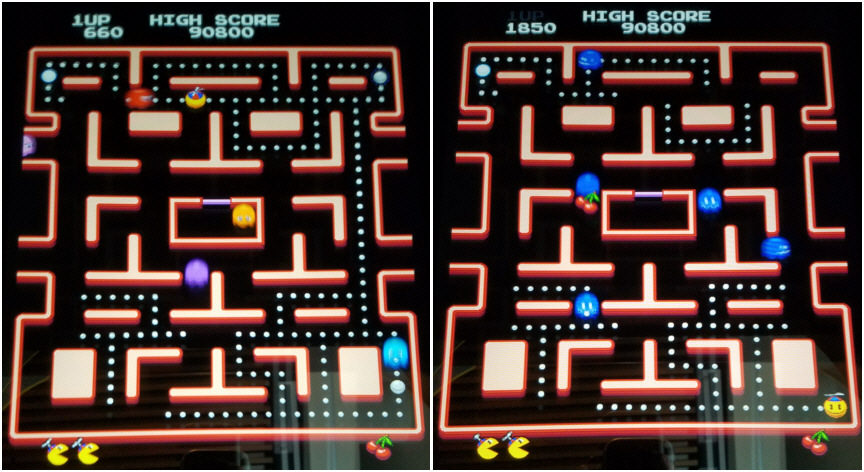
A custom game featuring
"modern" graphics, Jr. Pac as the player character, Sue as an extra ghost,
and other options
The entire game program was actually created from scratch and based upon carefully observing the behavior of the originals. Cabinet work and construction is by Brendon Parker, known for creating many custom Pac game builds including a totally custom Crazy Otto cabaret (the game that eventually became Ms. Pac-Man), Pac-Man & Chomp Chomp, as well as others he generously exhibits at California Extreme. Being a tremendous fan of Pac-Man Arrangement, Pac-Man Megamix takes everything that was cool about seeing an updated Pac-Man title and blends it back with the games that made the series what it is. Not only does it feature the three best core Pac games in one package, the Custom Game option opens these titles up to players of all skill levels while adding something new for Pac veterans. Simply put, Pac-Man Megamix is a celebration of three outstanding games and a gaming icon, with just enough of a modern touch to make everything feel like something new. While a fan project that is not for sale or distribution, this really is a title and concept that Namco should license from these two gentlemen, as it is an awesome game that seamlessly blends old and new with respect for all three games.
Well-known arcade board collector ShouTime was at California Extreme exhibiting his exA-Arcadia platform in addition to hosting three panels that I attended. These included a discussion with Minoru Ikeda, owner of Game Center Mikado, currently the top independent game center in Japan. ShouTime also hosted a question and answer session with Yugo Fujioka, lead programmer of the shooter Aka & Blue as well as a former member of legendary game developer Cave. In between those two panels ShouTime hosted an introduction and Q&A concerning his exA-Arcadia platform and the issues facing arcade operators in Japan as their industry declines. A large part of the issue has to do with ridiculous revenue sharing forced upon game center operators by manufacturers in Japan. Manufacturers take a huge slice off the top of any profit made, as much as 50% of all revenue dropped into a game, then charge exorbitant amounts on top of that for licensing, required network connectivity, printed goods such as game data cards, you name it - they take another cut. The exA-Arcadia platform is an answer to these problems with no forced revenue sharing, support without network charges, both JVS and JAMMA (with an adapter) compliancy, up to four games in a single cabinet, and a genuine upgrade path. It's also tremendously open to development as it is PC based.
For as much as the Neo Geo platform gets dismissed by many arcade collectors, it really was the only arcade platform to get things like maximizing operator revenue (with multiple games in a single cabinet) and providing a near endless upgrade path (plug and play new game titles) right from the beginning. From what I was able to ascertain from ShouTime's panels and talking with exA-Arcadia people, exA-Arcadia is similar to that but with more support on the game development side as it provides an extremely flexible development environment. There was a bank of cabinets running games on the exA-Arcadia hardware in a special exA-Arcadia section and all were very enjoyable titles. However the big draw for me was a prototype game that ShouTime was exhibiting publicly for the first time ever, SegaSonic Bros.
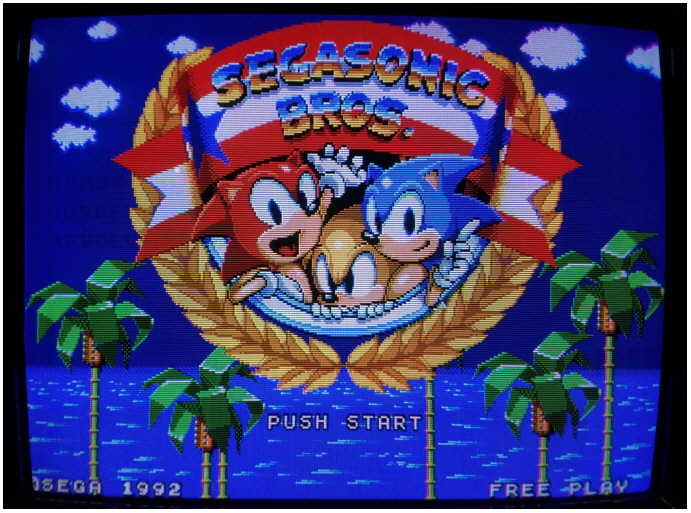
SegaSonic Bros. title
screen, featuring Mighty and Ray when they were originally hedgehogs
Developed by Sega in 1992, SegaSonic Bros. would see an extremely limited location test in Japan before disappearing completely. Re-discovered a few years ago and bought by ShouTime, very little was disclosed about the title other than it being a puzzle game. Starring Sonic and his red and gold brothers (who would be reworked into Mighty the armadillo and Ray the squirrel for 1993's SegaSonic the Hedgehog arcade game), SegaSonic Bros. is a unique take on a color-matching puzzle game. In fact after initially playing it I couldn't figure out exactly what was going on and figured it was simply a game in an incomplete state, not unheard of for a prototype. However after talking with one of the exA-Arcadia people about the game mechanics, it was explained to me and made perfect sense.
Clusters of hedgehogs drop onto the playfield in square groups of four. Pressing the button will rotate them, changing their position. Once they reach the lowest level of the playfield they will turn into orbs and come to rest. Unlike Columns or Puzzle Fighter, the objective isn't to make rows or clusters but rather to encircle territory on the playfield with matching colors. In hindsight, a puzzle game where the player is tasked with creating "rings" to remove spheres makes perfect sense in the context of Sonic the Hedgehog. Territory can be encircled with chains of color in any direction and the sides and bottom of the playfield can be used as well. As an encircled connection is completed, all objects within the encircled territory are swept away downward and the remaining orbs on the playfield are compacted. As the playfield fills up, a good strategy is to have veins of the same colors staged around one another, then loop them off with matching colors to create cascading combos. There's an electricity motif going on throughout, and if you think of same-color orbs as completing electrical circuits between the walls of the playfield, you'll be in a good mindset when approaching the game.
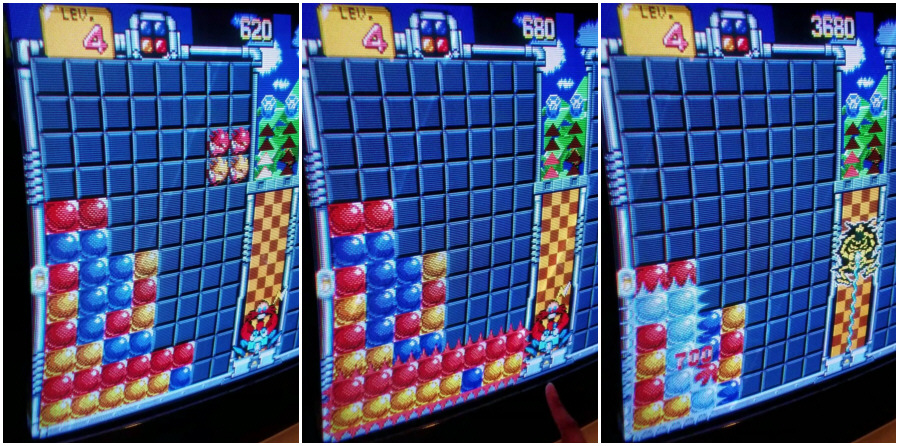
A cluster of red (Mightys)
and gold (Rays) fall toward the bottom of the screen where they will rest
(left),
This makes a chain of
red, which encircles everything below using the sides and bottom to complete
a circuit, cascading the orbs away (center),
Remaining orbs shift
down, allowing a chain of blue to contact the bottom and side, completing
another circuit and cascading more orbs away (right)
The game's speed ramps up quickly but as levels are completed it slows back down, following a curve of being relaxing, then intense, then relaxing once again - similar to some modern Tetris games. After completing enough combos a Chaos Emerald will be dropped onto the playfield. This functions as a bomb, destroying everything at and above the height it comes to rest at. In one game I was able to have a clear path to the very bottom of the playfield with a Chaos Emerald, and was awarded a 2X bonus in addition to big points for all the spheres it removed as it cleared everything out. In addition to a single-player game, there are also pair of two-player modes. The first is simply the single-player game for two players, without any interaction between the two halves of the screen. The second is a two-player competitive game which will send junk blocks over to your opponent after completing combos. The junk blocks take the form of clouds with skulls on them, looking a bit like something out of a Mega Man game. These can be eliminated by encircling them like everything else.
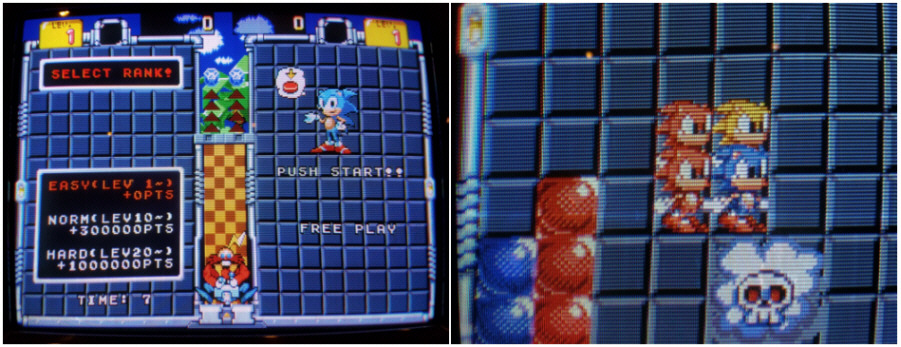
Starting level selection
(left), a cluster of hedgehogs settling atop a garbage block in a two-player
versus game (right)
Additionally, empty space can be encircled as well, as matching orbs will "latch" onto one another while falling if they are the final piece in completing a circuit. I thought this was a cool mechanic, especially with how frenzied the game can become, and opened up an extra avenue of strategy. I reached level 35 in one game and around level 31 or so a fourth color began to show up, essentially white frosted Sonics. This made things quite a bit more difficult and I can only imagine that alternate color Mightys and Rays show up eventually as well. After playing dozens of games it seems as if SegaSonic Bros. was 100% complete and ready to go before it was canceled, having failed its initial Japanese location test. Sure the mechanics are a little hard to grasp at first, but it does feature an attract screen (not seen at California Extreme as the game was set to free play) that explains how the game works. All weekend long people were playing it, both single-player and head to head versus. It's too bad Sega didn't release it as it's truly a unique take on a puzzle game. Thank you to ShouTime for exhibiting this game, as well as exA-Arcadia, at California Extreme this year!
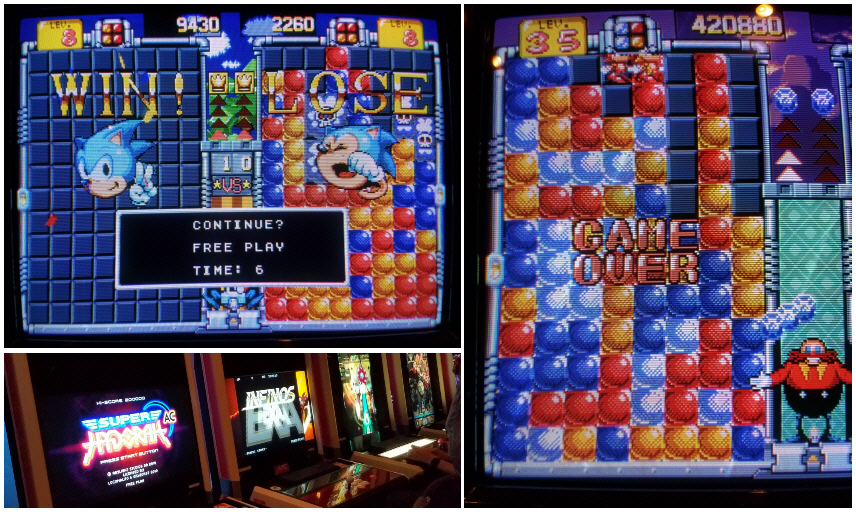
Player one earns a victory
in a two-player versus match (upper left), a fourth color is added in a
later level (right)
exA-Arcadia hardware
based games running in JVS compliant cabinets (lower left)
While Pac-Man Megamix and SegaSonic Bros. were both games I was looking forward to playing at California Extreme for a couple weeks prior to the show, there was a big surprise I encountered on the show floor. That surprise was Starlords, a sequel to Atari's classic attack and defense paddle game Warlords, originally released in 1980. The original Warlords pitted four players against one another, each a warlord protected behind castle walls and a moveable shield. A dragon releases a fireball into the arena and as it ricochets around it chips away at any castle wall it may come into contact with. The players can affect the position and trajectory of a fireball with their shield, controlled with an analog paddle and single button. Holding the button down will allow the shield to capture a fireball and release it as desired, however holding on too long will cause the fireball to begin to burn away at the castle walls. If a fireball comes into contact with a warlord they are destroyed and an additional fireball is generated for the remaining players to contend with. The warlord last standing claims the victory. The cocktail table version of Warlords, with its four player gameplay, continues to be a popular and valuable arcade game and an experience that is just as entertaining now as it was almost forty years ago.
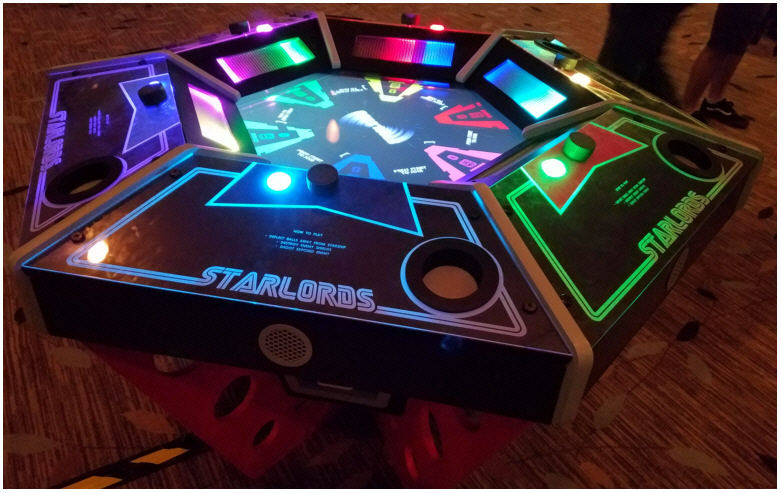
Starlords packs big action
into an eye-catching package
Starlords takes the core concept of Warlords and runs with it, resulting in a classic reborn for a new age. Rather than four players, Starlords expands to allow up to six players and places them in a hexagonal arena. As the name may suggest, the action takes place in deep space rather than a medieval battleground. Each starlord has a three-sided wall around them and is located along a side of the hexagonal playfield. In a nice touch, the icon that represents each starlord is in the same style as seen in Warlords. CPU controlled components have a humorous icon derived from the classic smiling Macintosh computer icon, except looking far more menacing - a "pissed Mac" if you would. True to the original, each player controls a shield with a paddle and has a button to catch and release the ricocheting ball. The first round plays much like standard Warlords, with a single square ball being introduced into the arena from a black hole that materializes in the center of the screen. As a starlord is defeated, another ball is generated from their destruction. Subsequent rounds are where things get really interesting as an additional ball is introduced into the arena every twenty seconds or so. This means the longer the game goes, the more mayhem is introduced. Eventually there are so many balls flying around the screen that it becomes nearly impossible to monitor them all. This makes for a fast and extremely frantic experience, both ridiculously intense and strangely Zen-like.
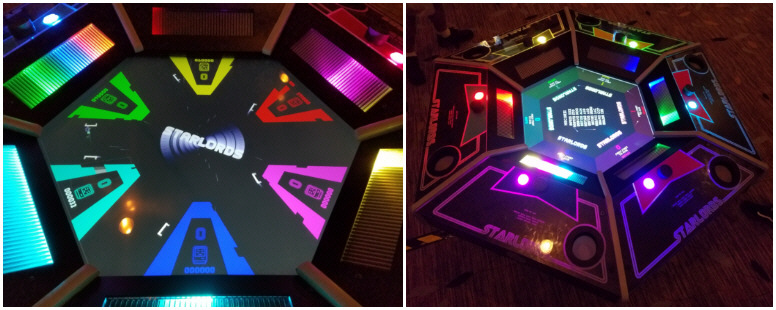
From design, to visuals,
to gameplay, Starlords delivers on the neon-colored dreams of the late
1970's / early 1980's arcade aesthetic
While the core gameplay and concept of Starlords is amazing all on its own, the presentation is where it is truly elevated beyond anything that has come before. The massive yet low-profile hexagonal cabinet features a sound and light show unlike anything I've ever seen in any other game. Each starlord station has an LED bar between the paddle and playfield that tracks to the movement of the paddle's position, illuminated the same color as the player's station. In addition the entire panel flashes white every time a section of a player's defense wall is hit. When a starlord is knocked out, the entire panel flashes and then is cascaded with the player's color. Think of a program being derezzed in the film TRON, it has that same effect. The button for each player to capture and release the ball constantly glows the player's color, cycling through all colors when held down to capture a ball. The lighting has an added effect of illuminating each player standing at the cabinet in the color of their respective starlord. Once a dozen or so balls are flying around the arena, the light show becomes pretty insane, and only adds to the tension of the game. The action is accompanied by a bass-heavy soundtrack that is perfectly at home with the gameplay and presentation.
Mike Mika (game design and programming), Sean Charlesworth (cabinet design and construction), and Jeremy Williams (electronics) truly created a new classic with Starlords. I talked briefly with Mike Mika both Saturday and Sunday of the show and he told me that response to the game had been that of universal praise, with many wanting to buy one if they go into production. I told him I don't drink but if there was a Starlords cabinet at a barcade or similar establishment I would go all the time just to play it. There were a few minor issues with the cabinet, such as the paddles becoming a bit spastic (which could be resolved by quickly moving them back and forth) and feeling a little light. However this was very much a field test of sorts to gauge reaction to the game, and the Starlords team is still working on further developing the game for possible production and distribution. Both days of California Extreme there were almost always people playing, and usually a full group of six players. In my opinion, Starlords was the game of the show for CAX 2018. As I commented at the show Starlords, simply put, is Warlords - with six players - in space - in the middle of a rave.
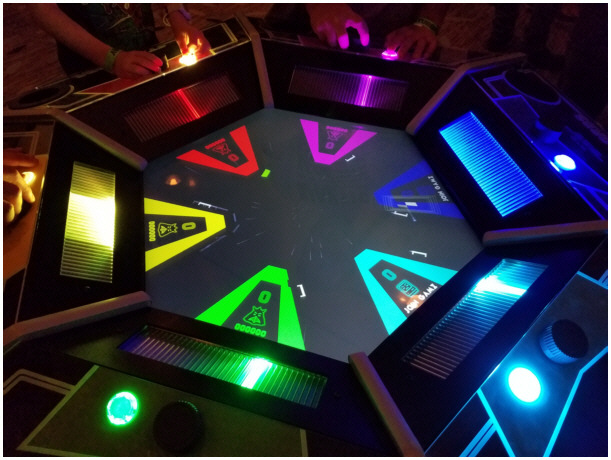
Ever seen the cover art
of Atari 2600 Super Breakout? Starlords is essentially that made real
It has been eleven years since I first attended California Extreme, and every year I enjoy the show more than the year previous. There's always something new to play in addition to classic and rare games that are a hallmark of the show. If you are reasonably local and have not been there, you owe it to yourself to check it out. If you attended previously but haven't been in a few years, it's time to head back again. From game selection and layout to facilities and content, there is something for every arcade game and pinball enthusiast at California Extreme. It continues to be both a huge show and a community hobbyist effort at the same time. I truly admire and appreciate that level of enthusiasm, generosity and hard work. As always, a tremendously huge thanks to the Extreme Team, exhibitors, volunteers and everyone else who comes together to host this show every year!
More information about California Extreme
can be found at http://www.caextreme.org
|
Welcome back as we continue our voyage with the CoolBoy Real Game 198 in 1 bootleg Famicom multicart. If this is your first journey with us, a bootleg pirate multicart is a video game cartridge containing multiple games that would otherwise have single cartridge retail releases. Pirate multicarts have become bigger and better over the past couple years. Although these days you have options such as flash memory cartridges if you want to play a bunch of games off a single cartridge, there's just something about these bootlegs that appeal to me. I've found collecting multicarts a fun collecting sub genre since the early to mid 2000's. Two of the currently most popular multicarts are branded under the "CoolBoy" name and are generally known as "198 in 1 Real Game" and "400 in 1 Real Game" and these cartridges are usually sold together as a pair.
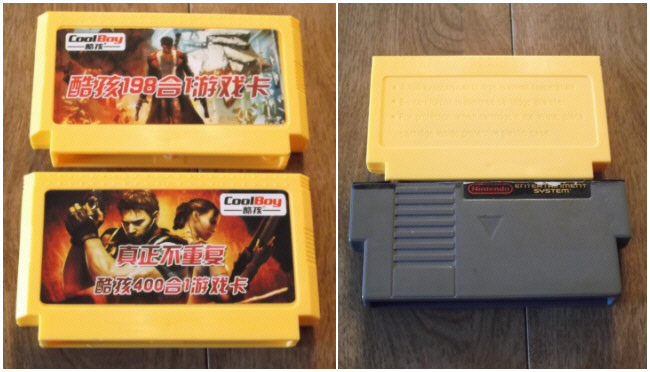
CoolBoy "198 in 1" and
"400 in 1" cartridges along with a custom made Famicom to NES converter
While the 400 in 1 cartridge contains more total games, I find that the 198 in 1 contains a more interesting mix of titles with less filler. This is due to the 400 in 1 cartridge containing more pirate originals including a rather large library of games released by Thin Chen Enterprise, the Taiwanese company better known as Sachen, history's most prolific producer of unlicensed Famicom games. While these games are an interesting collecting sub-genre onto themselves, and a sadly forgotten part of modern NES and Famicom collector culture, they're not necessarily all that fun to play. It should also be said that the back half of the game list for each cartridge is generally filled with these type of Taiwanese and Chinese pirate original games. The 198 in 1 cartridge isn't too bad in this respect, with fifty or so games falling into this category.
This scope of this ongoing column is to quickly evaluate the 198 in 1 cartridge, fifteen games at a time, until the entire list is completed. Additionally each issue will also evaluate a single game from the 400 in 1 cartridge that does not appear on the 198 in 1 counterpart. For the entire duration of this column, each cartridge will be played on an original toaster-style North American NES console. To convert the bootleg Famicom cartridges for play the NES, I will be using a Famicom to NES converter cartridge built from parts out of an early release copy of Gyromite. As a final note, many of the games contained on these bootleg cartridges have their title screens altered to strip away any copyright dates or the like.
Now, back on to high seas and high excitement!
As we move back into sequential numbering
for the remainder of the game list there are some good ones ahead today.
We have a few excellent action games, my pick for the greatest shooter
on the platform, and interesting imports from two different regions.
However we also have a couple of mediocre basketball games, a couple terrible
home conversions of arcade releases, an extremely rare competition game,
and much more. Let's set sail!
CoolBoy Real Game 198 in 1, Games 161 - 175:
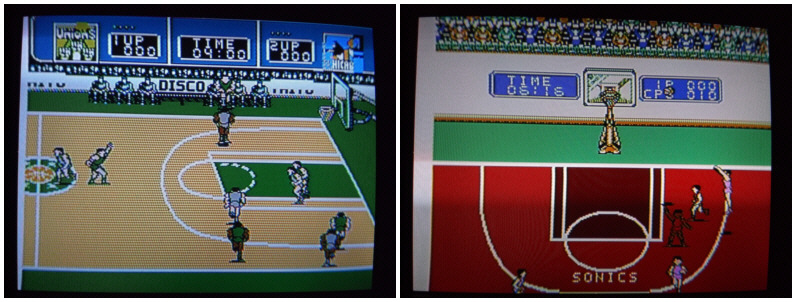
Taito Basketball and
All-Pro Basketball
161. Taito Basketball - While a sport far more popular in the United States than abroad, there were a surprising number of basketball games for both the NES and Famicom. Taito Basketball is the Japanese release of Ultimate Basketball, originally released by American Sammy in 1990 with Taito's Japanese release a half year later in 1991. Options are in line with sports titles of its day, with a standard single player mode, both cooperative and versus two player modes, and a mode to watch the computer play against itself. The single player and two player cooperative modes feature the option to play a single game against the team of the player's choosing or a simple bracketed tournament for the championship. Taito Basketball offers a roster of seven different teams however they are all completely generic as no official basketball licenses were obtained for either release of the game. Each of the teams does have varying strengths and weaknesses, adding at least a little variety to an otherwise barebones sports title.
Konami's Double Dibble was obviously a tremendous influence to the design of this game, featuring the same perspective, play style, cutscenes during big moves, and general graphic package. In fact it really seems as if Taito Basketball is a straight up assets lift of Double Dibble. The only real additions over Double Dribble are better animation and more player interaction during cutscenes, as they often feature a sliding gauge which must be activated at the correct time to pull off a technique. Yet I find the game to not play as well as Double Dribble, with relentless CPU opponents, ear-piercing music (especially on the title screen), stiff controls, and unimpressive colors. The frequency and ease in which CPU players can steal the ball is flat out ridiculous, often not even coming into contact with the player in possession. Some logo graphics have minor glitches and corruption here and there, more than likely due to the process of stripping the Taito branded graphics out of the game for inclusion on the multicart. This graphical corruption doesn't affect gameplay, which is just as poor on an original retail cartridge. Taito Basketball was actually developed by Aicom, a developer who made quite a few basketball games but sadly never had much consistency in the quality of their releases. This time out the resulting game is more irritating than entertaining, and even in a two player game there's not much to enjoy here.
162. All-Pro Basketbal - Going back to back with basketball titles, All-Pro Basketball is yet another basketball game developed by Aicom, published this time by Vic Tokai. Amusingly the last "L" in "Basketball" ends up being cut off by the character limit on the 198 in 1 menu, I guess they really wanted that hyphen in there. Rather than cloning a game developed by someone else as they would later do in 1990 with Taito Basketball, Aicom instead revisits one of their earlier releases for inspiration. Moero!! Junior Basket - Two on Two was a half court urban basketball game Aicom developed for Jaleco in 1988, who later released it on the NES as Hoops in 1989. Hoops is a pretty interesting game, a lot of fun, and an overlooked NES game in my opinion. All-Pro Basketball was released almost exactly one year later, first on the NES in 1989 and the following year on the Famicom. As Aicom had a perfectly functional basketball game engine with Hoops, it would make sense to pull assets from that title when developing another basketball game. The only problem is that Hoops is half court schoolyard basketball and this time out they were going for something more professional.
As with many sports games of the time, no official teams or players are featured but eight generic teams function as stand-ins for American organizations. The game can be played as a single player, two players on the same team, two players versus one another, or the little used CPU against itself mode. The court is presented from a vertical aspect which allows the player sprites to be reasonably large. Although the screen scrolls around to follow the ball, only half the court is displayed on screen at a time. Once the ball crosses the center court line, the game pauses while the screen fades black and changes perspective to swap the top and bottom halves of the court, along with the corresponding position of every player. This also reverses the direction everyone is facing, so if you were running down before the transition, now you need to change to running up before action resumes. Effectively this means the entire court is made up of a half court perspective with the hoop at the top of the screen. There are some visual indicators to help the player wrap their head around the direction swap, such as each half of the court being a different color and an arrow showing the changing position of the player in possession of the ball. However all other players disappear completely and then reappear in their new positions. Additionally if the ball crosses the center line in the middle of a pass no possession arrow is shown, instead all players simply fade out and are repositioned. This makes moving up and down center court a disorienting headache. In essence All-Pro Basketball is the half court gameplay of Hoops with a transition effect at the bottom of the screen to virtually double the court size.
It's a shame the perspective changes are so jarring as otherwise All-Pro Basketball plays relatively smoothly with some fast action and good control. There are a few different sprites used for the players and key moves feature cutscenes similar to those that were seen in Hoops, although they're given more of a Double Dribble professional basketball presentation. Colors are a little flat but good and when not transitioning at center court it's easy to keep track of player position. Unfortunately All-Pro Basketball can't shake its roots as a contact job, complete with terrible music and a title screen that looks like it was meant to be part of Jaleco's "Moero!!" series. The next time Aicom developed a basketball game for the NES they would abandon the vertical perspective, resulting in the aforementioned Double Dibble clone Ultimate Basketball, later released on Famicom as Taito Basketball. Of all the Aicom developed NES basketball games, All-Pro Basketball is far and away the weakest release.
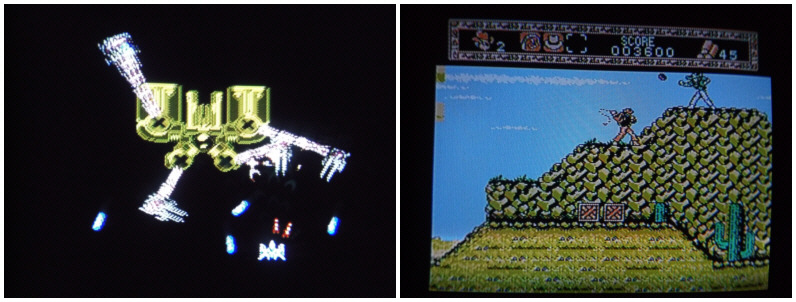
Summer Carnival '92:
Recca and The Young Indiana Jones Chronicles
163. Summer Carnival'9 - Easily the rarest game included in the 198 in 1 multicart, Summer Carnival '92: Recca was a game created for a Japanese shooting game competition hosted by Naxat Soft. Hudson Soft had been hosting an annual tournament and showcase known as the "Hudson All-Japan Caravan Festival" since 1985, focusing primarily on their stable of increasingly popular shooters. Naxat's "Summer Carnival" was a similar event, begun in 1991. For the second Summer Carnival the following year, Naxat offered Recca as a tournament game for the Famicom, a platform that Hudson had moved away from featuring in their tournament after 1987. This left Recca as a bit of an oddity, as most shooting game enthusiasts had moved to the PC Engine (released as the TurboGrafx-16 outside of Japan) many years earlier. As a comparison, the game featured in Hudson's 1992 Caravan tournament was the absolutely amazing PC Engine title Solider Blade. Even Naxat had moved most of their efforts to the PC Engine, with the PC Engine CD shooter Alzadick also being featured in the 1992 Summer Carnival. In fact both the 1991 and 1993 Summer Carnival exclusively featured PC Engine CD shooters, Spriggan and Nexzr Special respectively. This meant that Recca was manufactured in extremely limited quantities and was developed specifically for the competition as a "super hard shooting game" for the Famicom.
Popular opinion concerning Recca seems to be that it is a masterful work of shooting game art, pushing the Famicom hardware to its limits and rivaling early Super Famicom visuals. While I agree that the game has a rather interesting history and is undeniably one of the rarest production games for the Famicom, I believe its obscurity gives Recca more allure than it deserves. At its core Recca is a vertically scrolling shooter that features both a primary and secondary weapon, as well as adjustable ship speed. This had become the standard for console shooters in the wake of the PC Engine shooting game revolution that predated Recca. Both the primary and secondary weapons can be changed and powered up by collecting corresponding weapon pickups. While there is admittedly a good variety on offer, everything falls well within contemporary shooter conventions: spread shots, lasers, homing shots, etc. In terms of weapon loadout it's interesting that all the secondary weapons are in fact offensive cannons that are oriented differently depending on their type. This frees up the primary weapon to double as an energy bomb, which automatically charges up while the primary cannon is not being fired. Using the secondary weapons for offense and protection while the energy bomb charges is an interesting gimmick but it's attached to an otherwise uninspired game.
The most talked about feature of Recca is that it throws a ton of sprites on the screen at high velocity while maintaining a fast game speed. While this is true, the enemies have plain and uninspired designs and look like something from an earlier generation of Famicom shooters. The backgrounds are sparsely detailed and unimpressive, feeling very flat with dull colors. While the audio package and music isn't terrible, it's nothing worth praise and is a far cry from what Hudson, Konami, and Compile were putting into their shooters at the time. I can't believe the soundtrack to this game was given a CD release, in 2005 no less! Bosses are large and often fill the screen but they don't have much detail and again are really lacking in color and animation. They almost seem like the bosses from an earlier generation of Famicom game, where the boss would actually be the background layer rather than a sprite. Admittedly the game does move very fast, incredibly fast in some areas, but the whole thing plays like a flickering mess with rather imprecise ship control. Recca is often described as a "bullet hell" (danmaku) style shooter on the Famicom, but a true danmaku game would have precise control and adaptive shot patterns that allow for weaving in between enemy fire. Recca features neither of these things.
The true meat of the game takes place on the second loop, which features much longer stages and more variety, but making the game even more difficult doesn't address how limited its design is. I can understand someone loving Recca due to its high level of difficulty. However the difficulty always seems to be mentioned as an afterthought in comparison to the game's visuals. The problem I have is that Recca is neither a good looking nor good playing game. I find it preposterous that anyone can say Recca looks better than Salamander / Life Force (1987) or Gradius II (1988) on the Famicom. How about the amazing speed and stability of Guardic Gaiden / The Guardian Legend (1988) or the incredible visual variety and action of Gun-Nac (1990), both programmed by Compile and released on the Famicom years before Recca. Those are all better looking, better playing, and better sounding shooters that have a lot more to offer. The difference is all those games are fairly common, so they don't have the aura of absurd rarity surrounding them that Recca does. I may be in the minority concerning Recca but a lackluster shooter that runs at a zillion miles per hour is still a lackluster shooter.
164. Indiana Jones - Developed by Jaleco and based on the 1992 television series concerning the early adventures of the famed fictional archeologist, The Young Indiana Jones Chronicles is a side scrolling action platformer. Framed loosely around events from the first episode of the show, the game opens with an elderly Indiana Jones reminiscing about an adventure he had during the Mexican Revolution in 1916. Young Indy reminds me most of Konami's Rush'n Attack, as it plays a lot like a slightly more modern take on that classic. Indiana can run, jump, climb, attack, duck and crawl. Crates litter each stage and breaking them open will reveal weapons, power-ups, or gold bars. When unarmed, Indiana will throw punches and any weapon picked up will replace whatever he is currently carrying. Weapons range from his trusty whip to firearms, explosives, even a strangely useful rock. He may also find his fedora in the first level and gas masks in levels two and three. These act as armor and will allow Indy to absorb a hit without dying. Weapons work the same way in terms of absorbing damage, as the first hit will remove Indy's headgear and the next will take away his weapon, with an unarmed and hatless Indy dying in a single hit. Additional special power-ups will temporarily freeze all enemies or give Indiana a moment of invulnerability. For every one hundred gold bars collected, picked up three at a time, Indiana will earn an extra life. In darkened areas, torches and flashlights can also be collected for temporary illumination.
While tremendously better than the other Indiana Jones games on the NES, which were both terrible, Young Indy is far from deserving of the sterling recommendation it seems to get from the masses. Control is adequate and reasonably responsive but Indiana tends to slide a little too much when running, jumping, and landing. This can often cause delays when attempting to execute jumps, especially when on the move, and in some instances the jump input will simply be ignored. This causes a strange imbalance where Indiana runs like he's gliding on ice yet jumps like he's coated in glue. Jumping or falling any distance also causes Indiana to land on his knees, which cancels any input other than horizontal movement. While it could be said this is a realistic interpretation of movement, he will always slide on his knees if the direction he is facing when he lands is held, even up an incline. This creates an ever bigger problem than the sticky jumping, as while on his knees weapon input is canceled or even ignored. If he is in mid swing of his whip while in the air and catches a platform with his feet, the attack will be canceled instantly and all input other than left / right sliding movement will become inoperable. It only takes a split second for Indy to complete his landing but it's enough time to miss a jump or be hit by enemy fire.
Now there is some good here as the music is pretty good and the cutscenes are nicely done in the Ninja Gaiden cinematic style. In-game visual presentation is also reasonably solid, although the majority of the game never looks quite as impressive as the illuminated caves near the beginning, disappointingly becoming a wash of garish yet flat colors. The sprite work isn't bad but is really no more detailed than what was seen in Rush'n Attack. Those similarities to Rush'n Attack are what become most disappointing here, when one realizes that the majority of the game is Indiana Jones fighting in World War I, looking like a stock video game army guy. It simply doesn't look or feel like Indiana Jones. I'm going to venture a guess and say that a lot of people who sing the praises of this game never really sat down and played though the whole thing. While professionally designed and of good quality, The Young Indiana Jones Chronicles is only slightly better than your run-of-the-mill platformer based on a licensed property. If it weren't for the other Indiana Jones games on the NES being so horrendous, this game wouldn't get the free pass that it often does.
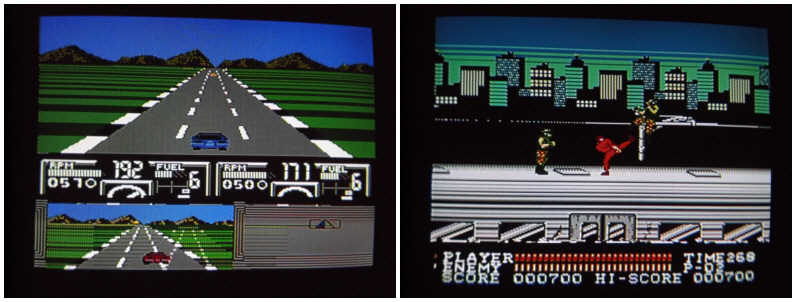
Race America and Spartan
X 2
165. Race America - While there were quite a few racing games released on the NES, and even more on the Famicom, most of them are strictly single player affairs. Race America is the opposite of that, emphasizing one-on-one cross country checkpoint racing and using the same two player perspective even when playing a single player game. For the single player mode, eight computer opponents of increasing skill can be selected from the start. Each leg of a race begins with a horizontal perspective drag race style start. The emphasis at the start is on acceleration and shifting as the cars are manual transmission only, with a complement of six gears. The accelerator must be released when changing gears, incorporating a tiny bit of realism. After driving out of the starting area while avoiding oil patches, the game changes to a behind-the-car perspective similar to Rad Racer, except with a horizontally split screen. The lead car is shown at the top of the screen while the trailing car is shown at the bottom. The top area takes up the entire upper half of the screen and plays like a conventional split screen driving game. However the bottom area is further split into two, with each player's status indicator at the top, and a tiny little rectangle under it containing the trailing car's play area. This makes things more difficult for the trailing player as their screen real estate is ridiculously small. The perspective again changes if the two competing cars approach one another at similar speed, this time to an overhead view. Once the cars have some distance between them, the view will change back to the split screen, with the trailing player at the bottom and the leading player at the top. First to the finish line wins the leg of the rally and proceeds to the next. The two player mode functions in exactly the same way but with two human players racing one another rather than a CPU opponent.
The driving itself isn't all that great and feels like a super barebones take on Rad Racer or OutRun with very little traffic or visual variation. Environments are flat, plain, uninteresting and all look exactly the same. The cars also always feel like they're sliding rather than gripping the road surface. The drag race starting area has some decent sound effects but so much of this game is played with nothing but the sound of an engine humming, resembling a game from an earlier generation of hardware. While Race America can be a bit of fun with a second player, the version included on the multicart has a pretty irritating graphic glitch. During the behind-the-car perspective areas that make up most of the game, the lower portion of the screen has some misaligned tiles and flicker that can obscure the display. This makes the game even more difficult to play for the trailing player and is glitched worse when player one is trailing. Additionally collisions tend to cause the entire screen to glitch out for a split second, making the game feel unstable. Even without the glitches this isn't one I can recommend. So many western developed games fall short of what was expected in a console game at the time and this is no exception. The concept of a two player head-to-head driving game on the NES is interesting but ultimately Race America doesn't have enough variety to make it fun.
166. Bruce Lee 2 - It's always nice to see a complete series of games included on the same multicart and such is the case with Spartan X 2. The Famicom exclusive sequel to game number 091 on the list, Spartan X, better known outside of Japan as Kung-Fu Master and to NES players simply as Kung Fu. Although Spartan X was a licensed tie-in with the Jackie Chan movie of the same name (known as "Wheels on Meals" in some markets), the game itself was heavily based on elements from Bruce Lee's unfinished film "The Game of Death." Apparently the multicart pirates were aware of this as well, which should explain the "Bruce Lee 2" title on the game list. In actuality, Spartan X 2 has nothing to do with either film and has only the most minor connection to the first game. A departure from the traditional martial arts visuals and pagoda climb of the original game, Spartan X 2 takes the battle to the streets as Johnny Thomas works toward busting up a drug syndicate, one thug at a time.
Video games had changed quite a bit since the original Spartan X had been released but Spartan X 2 plays in very much the same manner, albeit with a fresh coat of paint. Visuals are more in line with a Konami or Capcom action game and the perspective has more depth than even the arcade version of the original. Although it's still a single-plane beat ‘em up, there's good variety with an interesting assortment of environments to fight through. The stages where you begin atop a large vehicle, such as a train or aircraft, and then finish up by fighting the boss inside are among my favorites. All the same moves from Spartan X are back, along with an uppercut and shoulder throw that must be charged up by crouching briefly. It's a shame Spartan X 2 never had a release on the NES but six years had passed since the Famicom version of the original. Although an English localization as "Kung Fu II" was advertised in game publications of the time, this release never materialized. One can only assume that Irem ultimately felt a game as simple as this wouldn't have sold well in late 1991. A fan translation was released in 2003, translating the entire game into English under the title Kung Fu 2. For those who enjoy this type of arcade style scrolling beat ‘em up, this is one worth checking out.
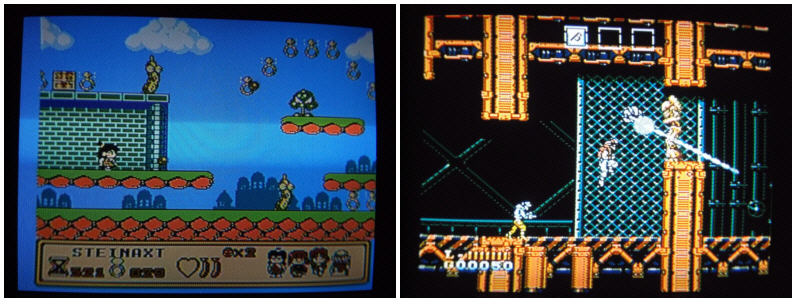
Banana Prince and Shatterhand
167. Banana Prince - Beyond the large Japanese and North American markets where Nintendo dominated with their Famicom and Famicom-derived hardware, the system found limited success as an official product in some European nations. Germany was one such country and a German localization of the Famicom game Bananan Ouji no Daibouken (Prince Bananan's Big Adventure) became a unique release for the region. Banana Prince is a typical platform game with an interesting mechanic. The prince can sprout large beanstalks from the ground at will and use them to fling himself upward or across large distances. Initially armed with a very short sword, he can purchase additional weapons in shops by trading in rings that he collects throughout each area. He can also find a sage locked away in treasure boxes that will provide defensive cover and can also be powered up for offensive assistance. In addition to shops there are casinos to visit, and a rather extensive quiz board game that plays out similar to a game show. Of course all of the questions are in German, which may limit accessibility if you aren't familiar with the language.
Visually Banana Prince is almost too bright with a lot of clashing colors and strange palette choices. Nearly everything on screen is constantly moving or spinning, right down to the status bar, a design ascetic sometimes seen in British developed games of the time. The prince's movements have a tendency to feel floaty, which plays against expectations as he cannot jump very far without use of the beanstalk. Nearly every stage has multiple paths to follow but this is a bit of a tease as Banana Prince only permits forward scrolling. Often times there will be routes that force him to bypass items that you would want to collect otherwise, simply due to being stuck on an alternate path from an earlier made decision. While this would usually contribute to a game's replay value, path diversions are far too frequent to keep track of, with literally every stage having something that will be passed up. In some respects Banana Prince plays a lot like the later Wonder Boy games but it is very much shackled to a less open ended era of game design. It's still a slightly above average platformer, especially considering that it was a one-off unique property. A rough literal English fan translation of the German version was released in 2003 and is worth checking out although it's not as polished as I feel the game deserves. Perhaps someone will take a fresh crack at an English translation one day, possibly translating the Japanese original version as well.
168. Shatterhand - A game that has already made an appearance on the multicart, at least in its Japanese form, Shatterhand is an action platformer developed by Natsume. After a young police officer named Steve Hermann loses his arms, he is given cybernetic replacements and is assigned to defeat a renegade military organization known as Metal Command. Steve's weapons are his cybernetic fists, which allow him to literally punch enemies into scrap metal. The strength of his mechanized arms also allows him to effortlessly scale and hang off of grated walls in the background. Additionally by smashing open item containers littered throughout each stage, "alpha" and "beta" icons can be collected. After picking up three icons a robotic satellite will be dispatched to assist Steve. The type of satellite called upon depends on the sequence of "alpha" and "beta" icons collected, eight combinations in all, each with a different attack method. Steve can combine with the satellite temporarily, gaining even more offensive strength, if the same sequence of icons is collected while a satellite is present. Coins can also be found in item containers and are spent at power-up pads throughout the levels. These act as on-the-fly item shops and can restore health, give a temporary power increase, or award an extra life. On the flipside, some item containers will house grenades, which will explode shortly after being uncovered and must be quickly avoided.
More of a "run and punch" than a run and gun, Shatterhand builds on the conventions and atmosphere of games like Ninja Gaiden and Batman. For the most part, Steve has to get right in the face of enemies, often knocking them back and then catching them on the rebound with a combination of punches. If Contra and Double Dragon had a child, it would be Shatterhand. Nearly every enemy will require multiple hits to defeat, even when powered up. This gives the game the sensation of chopping down your opponents, one metallic punch at a time. Steve's fists can be used defensively as well, as he can actually punch enemy bullets out of the air. Honestly I never quite got a consistent feel for this mechanic and tended to only use it as a last resort for shots I couldn't otherwise avoid. Unfortunately there is occasional control lag when the action gets heavy and a little more slowdown than I like to see in a game as fast-paced as this. Both visually and audibly Shatterhand is on par with the best action games the system has to offer and features a tough challenge that puts it right in line with the aforementioned Ninja Gaiden and Batman.
While the original Famicom version, Super Rescue Solbrain, was based upon a 1991 Japanese tokusatsu television show, the reworked NES version hit stores only two months after the Famicom release. For these two games to be released so close to one another, one would assume the two versions were co-developed around the same time. More than just a quick localization, in addition to new graphical assets for Shatterhand, Area C was replaced with a completely different stage. Unfortunately the version of Solbrain included on the multicart as game 018 (titled on the list as RoboCop 3 no less) is corrupted and only allows a very small portion of the game to be accessed. Thankfully Shatterhand works perfectly and the game can be played to completion. This is an outstanding title that should have a much larger following.
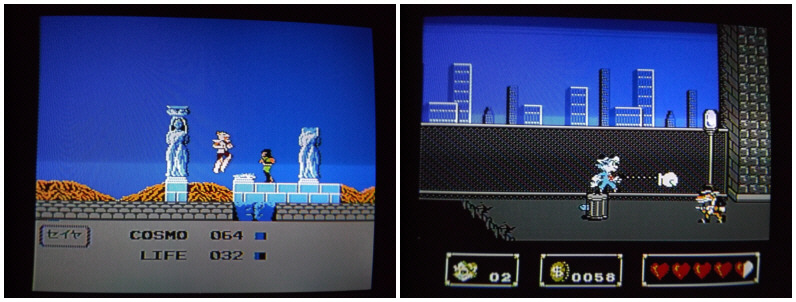
Saint Seiya: Ougon Densetsu
Kanketsu Hen and Rockin' Kats
169. Saint - Based on the long running Japanese manga and anime franchise, Saint Seiya: Ougon Densetsu Kanketsu Hen is the second and final Saint Seiya game for the Famicom. Saint Seiya concerns a group of spiritual warriors who fight wearing mystical battle armor themed after different constellations. This should explain why it was renamed Knights of the Zodiac in many regions outside of Japan, sometimes using a combination of both titles. For the most part Saint Seiya plays like a standard licensed action game with endlessly respawning enemies that are easily dispatched with close range attacks. There's little variation in these action scenes and control is pretty poor, with the expected terrible jumping usually found in Famicom games based on a licensed property. If that were all the game had to offer then this would be relegated to the trash pile of typical quickie anime cash in titles but there's a little more on offer here.
Character interactions in between scrolling areas are presented in the style of a third-person RPG, resembling Sega's Phantasy Star games, at least in perspective. Boss battles also play out from this viewpoint and are menu driven. Character portraits and sprites are fairly well drawn and animated during these sequences, certainly a lot better than in the rest of the game. During attacks there is some pretty crazy screen flashing that borders on headache inducing, even for someone such as me who is usually not affected by such things. Ultimately the entire game plays out in exactly the same manner, with increasingly frustrating jumps making the scrolling areas progressively more of a chore and more characters being introduced in the menu driven sections. The Japanese language barrier will be the biggest hurdle for most looking to play Saint Seiya, although an English fan translation was released in 2010. The version included on the multicart is hilariously missing nearly every graphic on the title screen, apparently the only way the software pirates could hide the copyright.
170. Rockin Kats - An action platforming game with a unique style, Rockin' Kats was sadly lost in the shuffle of NES action platformers. A parody of zoot suiting 1940's American culture, players take control of a Willy, a jazz cat armed with a punch gun. His punch gun fires a glove on an extending spring, similar to the famous Ultra Hand toy created by Gunpei Yokoi and sold by Nintendo in the 1960's. The punch gun can not only be used to hit enemies but also grab and throw objects. It is also used as a spring to bounce higher than a jump by shooting downward, or to grab onto and swing from platforms like in Bionic Commando. Similar to Bionic Commando, being able to execute consecutive actions with this special weapon is essential to advancing in the game.
Willy will pursue Mugsy the mobster through a series of unique stages in an effort to rescues his girlfriend Jill, who Mugsy's gang has kidnapped. Stages are presented as channels on a television set, each a unique location that can be selected in any order, other than the final channel which must be played last. In addition a shopping channel allows Willy to spend collected money on power up items. Rounding out the television stations is the bonus channel where Willy can play minigames to earn money and extra lives. Rockin' Kats is easily one of the nicest looking NES games with tons of personality in its character designs, clean graphics, good animation, and outstanding color usage. It features upbeat and catchy music with consistently good sound design throughout. Along with the challenging yet satisfying mechanic of the punch gun, Rockin' Kats is a fully developed and highly polished take on the action platformer. In fact the only fault I can give this game is that it's rather short, even with the very challenging areas toward the end.
I remember reading about Rockin' Kats in Nintendo Power magazine and although I really wanted to play the game I never came across a copy of it in stores or for rental. In fact to this day Rockin' Kats is one of the few NES games that I've never seen an original cartridge of in person. Although not extremely scarce, it is a very uncommon game and sells for ridiculous prices on the secondary market, making its inclusion on the multicart a nice addition. For those who have never played this one, definitely give it a try.
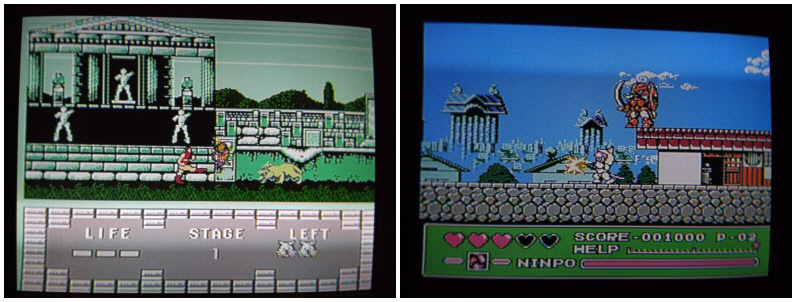
Juuouki and Kyatto Ninden
Teyandee
171. Juuouki - Meaning "Beast King Chronicle," Juuouki is the Sega arcade beat ‘em up known as Altered Beast outside of Japan. Set in ancient Rome, Altered Beast stars a fallen centurion whom Zeus revives to rescue his daughter Athena from the clutches of Neff, an evil demon god. While a relatively weak mortal, the centurion can collect spirit balls from defeated enemies that allow him to progressively power up. Collecting three spirit balls will transform the centurion into beast form, which differs depending on the stage. Each beast form grants special attacks that are useful in defeating the large bosses that each area concludes with. Upon completing a stage the centurion reverts back to his weakest form, as Neff steals the spirit balls after each boss is defeated. Altered Beast was released on nearly every home video game system of the time, no matter how underpowered, to varying results. The Famicom version is easily one of the worst with microscopic sprites, muddy colors, and very little detail throughout. Enemies also tend to spawn directly on top of the player without any warning, making the already stiff controls feel even less responsive. Music and sound effects are consistently terrible and the whole game chugs along at a snail's pace. While the end of stage bosses may be large they are very poorly animated, as are the centurion's special attacks while in beast form.
Now Altered Beast is a game that tends to divide gamers between those that regard it as an absolute classic arcade game and those who consider it to be a slow and repetitive slog without much substance. In the 1980's the Round Table Pizza closest to where I grew up always featured a really solid selection of arcade games and this extended well into the late 1990's. Their arcade area wasn't very large, three or four arcade cabinets and a couple popular pinball machines, but new games were always rotated in and they were always in good order. In the late 1980's they installed a brand new Altered Beast cabinet. I was about seven years old at the time and while the machine always seemed to attract a couple of teenagers to play it, I thought the game was boring and moved way too slow to be fun.
A couple years later when a reasonably faithful home conversion was included as the pack-in game with the Sega Genesis in North America, it was once again praised as an amazing game, and once again I found it slow and boring. In the late 1990's when I got into emulation while in high school, I gave it yet another chance, and still found it slow and boring. In the early 2000's when I was playing emulated arcade games on a regular basis, I gave the original another shot, and it was still slow and boring. At the California Extreme arcade and pinball show just a few years ago, I played through the entire game on an original cabinet and guess what - it was still slow and boring! It may be my opinion but Altered Beast has always been slow, unimpressive, poorly designed, repetitive, and one of the most boring and uninteresting games ever created - then, now, and forever. I suppose the terrible Famicom version fits into that tradition nicely. There's a reason why Makoto Uchida's next creation, Golden Axe, went on to become a franchise while Altered Beast became little more than a footnote in Sega's history.
172. Ninjacat - A game based on a licensed property that is far better than it should have any right to be, Kyatto Ninden Teyandee (Cat Ninja Legend Teyandee) is an action platformer based on the 1990 Japanese animated series of the same name. This one is a bit less obscure than standard licensed Famicom fare, as the television show was reworked and released in English as Samurai Pizza Cats in 1991. Edoropolis is a sprawling city that is home to a population of anthropomorphic animal androids. The mischievous prime minister Kitsunezuka Koon-no-Kami seeks to overthrow the Shogun and rule Edoropolis. The city's only hope is a team of cat ninjas: Yattaro, Sukashi, and Pururun, who have day jobs at the city's pizzeria. Known as the Nyankii, the three ninja cats are dispatched to maintain peace in a world that combines Japanese feudal culture with modern technology.
Each stage is presented as an episode of the show would be, complete with a long animated introduction cutscene. The player then chooses one of the three Nyankii before setting out, each with a different primary attack (always a slashing weapon) and special techniques. Each cat has three different special techniques, with the currently active special technique changing each time a ninpo icon is collected. Using a special technique drains ninpo, which translates to "ninja techniques" or "ninja arts," making the game play a bit like a cutesy version of Ninja Gaiden. Additionally pressing the Start button will bring up a menu allowing selection of one of four helper ninjas, each with their own special abilities: Rikinoshin can smash large boulders, Mietoru has wings and a propeller to fly with, Gotton can burrow through soil with his drills, and Nekkii has diving equipment allowing free movement underwater. Generally the helper ninjas are used to open up alternate routes or hunt out extra power up items. All four of them pull energy from a "HELP" meter that drains as they use their special ability. This energy slowly recovers once a main character is rotated back in but it can also be replenished instantly by picking up a bell icon. The implementation of these special characters reminds me a lot of Capcom's Little Nemo: The Dream Master, and how the animal helpers in that game were used to expand gameplay.
Everything in Kyatto Ninden Teyandee is colorful, detailed, and very well animated. Audio is equally well done with appropriate sound effects and outstanding music. The source material is not only used but respected, a rarity for licensed games as they're usually made as cheaply and quickly as possible. The entire game really does play as if it were a series of episodes from the show, complete with long animated dialogue exchanges and closing episode narration. For all its style and complexity it should be noted that this game is relatively easy as action platform games go. I honestly believe the intention wasn't to make a difficult game but rather a fun and accessible game that plays smoothly from beginning to end, even if a full run will only take an hour or so. The variety of special techniques between the three main characters adds some replay value and many stages have multiple paths and hidden areas. It's not surprising that Kyatto Ninden Teyandee shares a lot of gameplay ideas with Ninja Gaiden, as both were published by Tecmo. This is an action platformer that deserves to be right up there among similar offerings from Konami and Capcom.
It should also be mentioned that a pair of rather excellent fan translations for this game were released by Vice Productions (www.foxhack.net) in 2012. One patch accurately translates the original game into English, while the other is rewritten in the spirit and style of the Samurai Pizza Cats USA TV show, complete with a re-creation of the English theme song.
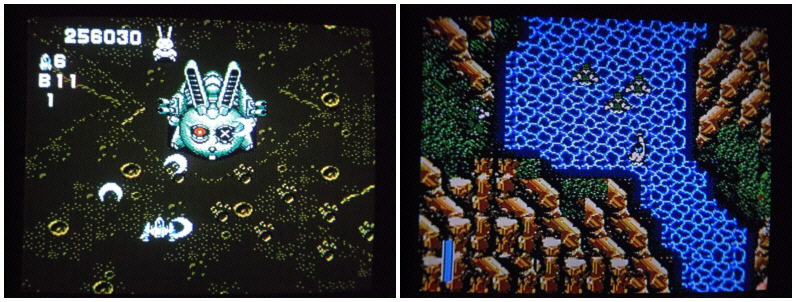
Gun-Nac and Ikari III:
The Rescue
173. Gunnac - Shooting games are one of the most prolific genres on both the Famicom and NES, both in terms of original titles and arcade conversions. Gun-Nac is one of the least talked about NES shooters and one of the most overlooked games in the entire system library. A system of seven planets orbiting an artificial sun is thrown into chaos as animals, plants and inanimate objects begin to attack the citizens of each planet. A request is made to the Space Police to solve the problem, with commander Gun-Nac summoned to investigate the incidents and restore peace. Rumor has it that a powerful invader is the cause of the pandemonium plaguing the solar system. Assuming the role of commander Gun-Nac, the player pilots a small starship in this vertical shooter.
Gun-Nac's ship features an impressive standard cannon that fires a rapid stream of energy shots. The primary cannon can be upgraded or changed to one of five different weapons by collecting numbered circular power up items. These include the multidirectional Blaster, the Screen Buster that spreads side shots from large energy orbs, the crescent shaped homing Search Driver, a continuous flame thrower called Dragon Napalm, and an array of lasers called Wide Beam. Collecting the same numbered powerup in succession will increase the weapon's power level and characteristics. Collecting a different numbered powerup will change to that weapon without a power increase. The secondary weapons have multiple types as well, affecting the type of bomb that is dropped. These are obtained by collecting lettered square power up items and include a standard circular Fire Bomb, a Blizzard Bomb that spreads a wave of destruction horizontally, a Thunder Bomb that bounces around the screen in a diagonal grid, and a Water Bomb that rains down giant raindrops of annihilation. As with the primary weapon, collecting the same bomb letter in succession will increase the bomb's power level and characteristics. Bombs always pull from the same ammunition stockpile but as they are powered up they drain more ammunition per deployment. Additionally a ship expansion called the Wing can be picked up, which increases power and allows an extra hit before the core ship is destroyed. All items will drift back and forth down the screen before scrolling off at the bottom if not collected.
The weapon loadout alone makes Gun-Nac have more in common with a PC Engine / TurboGrafx-16 shooter than similar offerings on the NES but it's only the beginning. The entire game plays silky smooth and zips along at impressive speed. This should be no surprise as the game was developed by Compile, who always seemed to be able to get every ounce of power out of the console. Background graphics are some of the best seen on the hardware, both while in space and flying over planetary terrain. Gun-Nac features quirky enemy designs that lean toward the random and comedic. Every single enemy has outstanding detail and a unique style with near endless variety. Bosses are equally as impressive and interesting with large sprites and varied attack patterns. Additionally colors are bright and vibrant from beginning to end, with easy to identify enemy projectiles throughout the entire game. Gun-Nac's music is a perfect shooter soundtrack, complemented with short event tunes and unobtrusive sound effects. It really sounds like something Hudson would release on the PC Engine. To add some strategy, a supply shop accessed between stages allows the player to spend collected money to power up or reconfigure their ship's armaments.
A cool feature in the options menu (presented as CONFIG.SYS) is to select whether the game's speed or sprites have priority, exchanging a blistering frame rate for less flicker. This becomes important when playing on the expert difficulty as there are a lot more enemies and projectiles to deal with. The frame rate is still really good no matter the setting and completing the expert difficulty awards an extra ending screen. The NES release is the version included on the multicart, which had some changes over the Famicom original. While the NES version is still zany and difficult, a number of sprites were changed to adhere to Nintendo's censorship policies of the time. Additionally the story was even more comedic originally, with the player character being a Shinto priestess who summons the spaceship and has to pilot it herself.
Gun-Nac is not only a wonderful vertical shooter, it is my pick for the best all around shooter on both the NES and Famicom. From a technical standpoint it is easily one of the most impressive games on the hardware. That level of quality extends to every aspect of the game from visual design, to play control, to music, to simply being an outrageously fun game. It truly is a marvel of 8-bit shooter design and should be celebrated as such.
174. Ikari 3 - Thankfully the final entry in the Ikari Warriors series, Ikari III: The Rescue attempts to actually deliver a semi-playable outing on the NES. This time the Ikari Warriors, Paul and Vince, are assigned to rescue the kidnapped daughter of a presidential candidate. Rather than being armed to the teeth and hopping into tanks and other vehicles as they progress, Ikari III places a much heavier emphasis on hand-to-hand combat. In fact the game plays more like a three-quarters perspective beat ‘em up rather than an overhead run and gun like the two previous games. While weapons can still be found, they are extremely infrequent and very limited. I swear there are more weapons to be found in Double Dragon than in Ikari III. Paul and Vince have the standard move set of a punch, kick, and jump kick. Unfortunately they can only face in the four cardinal directions while enemies can attack from any angle.
While the game plays like a beat ‘em up, someone forgot to tell the enemies they weren't in a shooting game anymore. Every single enemy soldier moves at about three times the speed of the player and is uninhibited by terrain. Most enemies are on a set path and will run out, beat the snot out of the player, then dash off back to their starting point, only to repeat the process until they are defeated. While the collision detection is horrible in regards to the player attacking an enemy, the exact opposite is the case for enemies attacking the player. Enemy attacks always find their mark and it's very easy to get into a situation where a stack of enemies will constantly pummel the player, without an opportunity to respond. Play control is rather abysmal as with only a few enemies on screen control begins to become unresponsive, further compounded by the poor hit detection. This time out unlimited continues are included without the use of a code but it feels more like compensation for an unfair game rather than a design choice.
If there is a high point of Ikari III it has to do with the presentation, as the game looks much better than the previous titles. In fact it looks like something you would see from an early Konami offering on the hardware, with accurately proportioned characters and good color. The original Ikari Warriors was a poorly programmed and frustrating game on NES and the sequel Victory Road was downright awful, so Ikari III tends to be regarded as reasonably decent in comparison. That's like saying a broken arm is better than having one amputated - it may be true but given the choice you wouldn't want either. Adding insult to injury, the version included on the multicart has glitchy vertical movement, with the entire background stuttering as it scrolls. Unfortunately most of the game scrolls vertically so this makes Ikari III even less enjoyable. There are also graphical glitches everywhere, including lots of stray tiles. I suppose that even CoolBoy is saying to just skip this one.
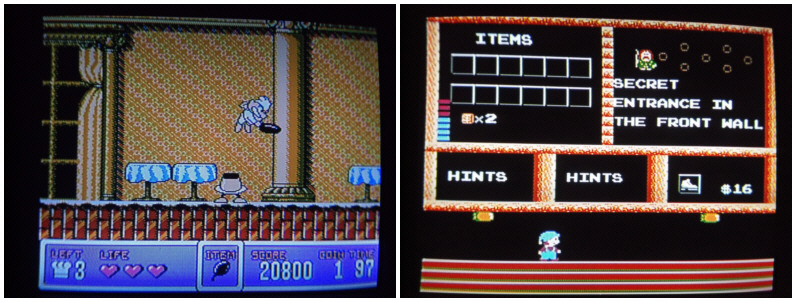
Panic Restaurant and
Milon's Secret Castle
175. Panic Restaurant - The mad chef Ohdove has taken over the Eaten restaurant, overrunning it with mutant food and possessed kitchen appliances. Armed with a frying pan, chef Cookie sets off to defeat Ohdove and stop his army of culinary creations. Panic Restaurant combines the enemy concept of BurgerTime with the gameplay conventions of a weapon based platformer. Cookie moves, jumps and attacks smoothly with responsive controls and predictable movement. So many of these wacky NES games tend to be quickly slapped together with poor hit detection and terrible play control but this is absolutely not the case with Panic Restaurant. In addition to Cookie's frying pan, other weapons can be picked up as the game progresses. Unfortunately these are static pickups, always the same alternate weapons in the same locations. Only one weapon can be held at a time and taking a cue from Ghosts ‘n Goblins, it's possible to mistakenly pick up a weapon that can be a hindrance rather than a help in some areas. There are a couple parts of the game where grabbing an alternate weapon essentially sets Cookie up to take damage, usually revolving around the fork, which is used like a pogo stick. The fork changes Cookie's size and movement to the point where he no longer seems to fit in with the stage dimensions or enemy patterns. The other weapons all have their advantages and disadvantages but the fork really feels out of place.
Panic Restaurant looks great with large
and detailed sprites, lots of animation, and tons of personality.
Boss encounters are not only patterned well but feature very impressive
enemy designs that perfectly fit in with the restaurant ascetic.
Action platform games were extremely common on the NES, so taking a different
route in terms of visual presentation is a great way to make a game stand
out. Sound design is average but appropriate with music and sound
effects that complement the action but don't really stand out. Bonus
areas add some variety, including a slot machine where Cookie can spend
picked up coins in an attempt to win extra lives or power ups. Thinking
back, it's funny just how many NES games featured slot machines in one
way or another, even if the rest of the game was totally unrelated to gambling.
Other bonus games involve grabbing fish with an extending glove or catching
falling eggs in a frying pan. If Panic Restaurant has one failing
it's the game's difficulty. For such a cute looking hop-and-bop the
enemies and traps can become downright overwhelming. Cookie is also
a rather large character, which makes it very easy for him to get tagged
by an enemy. The game was actually made more difficult for the NES
release over the Famicom original, not only by moving items around but
removing many of their locations. Unfortunately the NES release is
the version included on the multicart. Panic Restaurant is well designed
and entertaining but it can also be frustrating and a bit more challenging
than it was originally intended to be.
CoolBoy 400 in 1 Real Game, Spotlight Selection:
042. Milon's Secret Castle - Often bemoaned as one of the worst games ever released on the NES, Milon's Secret Castle is an action-adventure game that deserves another chance. Looking to find other people like himself in the world, Milon sets off on a journey that leads him to Castle Garland. The castle is under siege by the evil demon Maharito, who has occupied its walls with his army and imprisoned Queen Eliza deep within. Armed only with a magic bubble, Milon attempts to solve the puzzle of Castle Garland, defeat Maharito and rescue Queen Eliza. While Milon's Secret castle may look like a platform game, it has more in common with adventure games such as The Tower of Druaga, except viewed from the side rather than overhead. Garland Castle is presented as a large maze with multiple floors, towers, and interconnected rooms. A large portion of the game is figuring out how the individual locations are connected to one another and how to gain access to more and more of the castle.
Aside from shooting bubbles Milon can run and jump but has limited firing range and jumping distance. The key to expanding Milon's skill set is in visiting shops and purchasing items and upgrades. There's a lot of inventory here but it's all automatically applied once obtained. Bosses must be defeated to gain access to higher floors of the castle, further compounding that the main objective of the game is figuring out how to get further inside. Sure, rescuing Queen Eliza is the ending goal but she is trapped in the deepest reaches of the castle. A common complaint is that nearly everything in the game is hidden - from replenishment items to keys to doorways, and must be shot with bubbles to be revealed. Admittedly there's a bit of tedium to this but no items are ever randomly placed and the level design tends to lead the player toward what they need. Additionally Milon fires bubbles very quickly, meaning uncovering hidden items happens frequently. If you keep firing you'll uncover what you're looking for. This is definitely not a game for people who need their hand held or would rather play a single direction scrolling game.
I do have issues with Milon's Secret Castle
but they primarily have to do with an item obtained near the end of the
game that allows Milon to jump higher. This sounds like a welcome
upgrade and is required to complete the game but it completely changes
the basic jumping physics, requiring them to be re-learned. The bosses
also take way too many hits to defeat, dissolving into endurance matches
where a slight mistake will lead to a game over. It would be nice
if it was easier to replenish Milon's life meter as constantly defeating
the same enemies to build up hearts can wear a little thin. I never
had a problem with having to hold Left + Start to continue a game, this
was actually a really common method in early Famicom games and this one
was released in 1986. I have completed this game and I agree that
it is very challenging, one of the more difficult games of its time.
This is a game you have to work at, find every honeycomb to increase your
life meter, and approach with both problem solving and fast reflexes.
I suggest more people give this one a try but keep in mind this is a slower,
more difficult adventure than many later NES releases.
Next time we'll head toward the final couple
of journeys as we begin to approach the end of the game list. The
next fifteen games will feature a few solid action titles, a strange trio
of hacks starring Mario, and the game often considered to be the worst
Disney game Capcom ever developed. We'll also have an unreleased
English prototype, a multi-genre action game, an amazing Konami game that
tends to slide under the radar in more ways than one and lots more.
See you then!
|
In 1986 Nintendo was at the top of their game with the Nintendo Entertainment System. Back in those days you were wither team Nintendo or team Sega. Personally, I was on the Sega side and love the Sega Master System. The games and the graphics were ahead of its time and gave Nintendo games a run for their money. The controller for the Master System was basic, yet effective in what it needed to do to make the games entertaining and easy to play.
The look of the controller was very similar to the NES with a control pad and two button layout. Rather than the plus looking control pad the NES worked with, Sega made an almost circular controller pad to make not only up and down easy, but diagonal as well. Instead of A and B buttons, it has 1 and 2. The one missing element on the controller are the select and start buttons. Later in the Master System lifespan there were other types of controllers, but this was the standard controller that came with the system. The cord was the typical length, but in my opinion could have been longer. I still am surprised when the older systems made the cords they were not that long. Later in the 1990's some of them had long cords but not many. Another cool feature is the place where you plug in the controller was universal for the next generation console and you can use the Sega Genesis controller on the Master System. There were some additions to the control family for the Sega Master System. There was an item called the Control Stick. It was a much larger controller with the buttons being on the left side and the huge knob looking control stick on the right side. In my opinion this was not a good addition and I really didn't use it much. Personally, I prefer the standard controller out of the box.
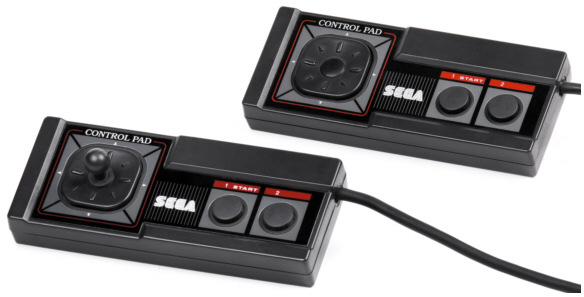
There were definitely memorable games for the Master System. Some titles today are hard to find and worthy of any collector. One of my favorite titles and most poplar games in my opinion back then, was Alex Kidd in Miracle World. This unique game had the player controlling Alex Kidd in multiple ways. You could scroll to the left and right as well as up or down to find hidden screens and powerups. Alex's punching ability is used to destroy enemies and to break rocks in order to access new paths and to collect items such as money which can then be used to purchase other items including vehicles such as motorbikes and helicopters. There were even swimming levels where you would need to punch and swim your way to the end.
Another favorite game of mine was Fantasy Zone. This game brings back many memories of trying to get farther in the game which was a challenge. The main character, Opa-Opa, is sometimes referred to as Sega's first mascot character. The controls were pretty simple as you would fly your ship around and shoot the enemies in a fantasy world. This side scrolling game allowed you to move left or right and scroll the screen in either direction. This was similar to Defender in the arcade. Along with shooting you could drop bombs on the enemies below. After each enemy is killed, coins come out and you can collect these to purchase items four your ship in the Shop. The graphics are pretty cool looking for an 8-bit system. The smoothness of controlling your ship with the controller is very good. Dodging the enemies is as easy as moving the control pad in any direction.

Alex Kidd in Miracle
World, Fantasy Zone, After Burner
The last game that made my top list of master system games is After Burner. I was a huge fan of the arcade game where you actually felt like you were in a dogfight with aircraft. The Master System did a great job of replicating the arcade. The graphics were top notch for the times. The sound was accurate as the arcade and the controls were just as good. If you moved the controller left then right quickly, you would do a roll, which was important to dodging the other planes bullets. The game had 15 levels and to complete all of them and beat the game was very challenging. Still today it is one of the hardest Sega Master Games to beat.
All in all, the Sega Master System controller
was not state of the art but simple enough to compete with its competitors
and make game control easy to learn. There were other controllers
for the system but in my opinion, nothing beats the original.
|
Every Friday on The Retrogaming Times Facebook page (facebook.com/theretrogamingtimes), we present a Weekly Retrogaming Trivia question. This just-for-fun trivia challenge provided each week is an opportunity to test your arcane and oddball retrogaming knowledge. The answer to the question from the previous week is posted along with a new trivia question every Friday!
Below is the recap of all questions and
answers posted between this issue and the previous issue:
06/29/2018 - WEEK 71
Question: Although never
released in Japan, what NES game was originally developed for Famicom under
the title of Arc Hound?
07/06/2018 - WEEK 72
Question: What piece
of music plays during the bonus stages in Taito's arcade game Great Swordsman?
07/13/2018 - WEEK 73
Question: NEC and Hudson's
follow-up to the PC Engine, what home video game system only had six retail
game releases?
07/20/2018 - WEEK 74
Question: Alphabet Soup:
GORF was an arcade game released by Midway in 1981. What is "GORF" an acronym
of?
07/27/2018 - WEEK 75
Question: What are the
names of the undercover police officers who star in Taito's 1988 arcade
game Chase H.Q.?
08/03/2018 - WEEK 76
Question: Alphabet Soup:
H.E.R.O. was an Atari 2600 game released by Activision in 1981. What does
"H.E.R.O." stand for?
08/10/2018 - WEEK 77
Question: What is the
only Nintendo Entertainment System game to be based on a movie that won
the Academy Award for Best Picture?
08/17/2018 - WEEK 78
Question: What five
games are ColecoVision Expansion Module #2 compatible with?
08/24/2018 - WEEK 79
Question: What was the
only tabletop VFD (vacuum fluorescent display) game that Parker Brothers
released?
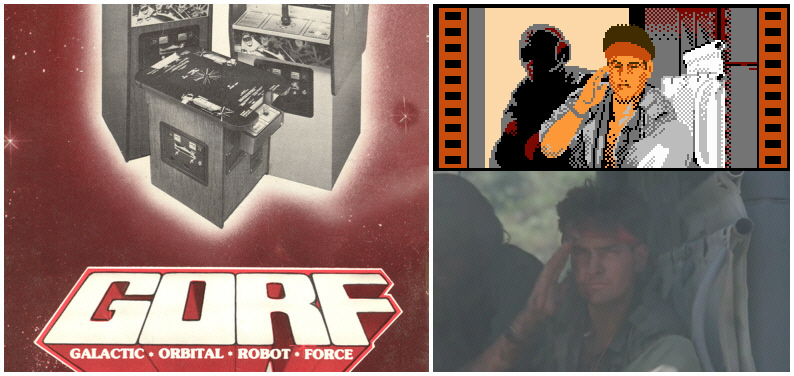
An arcade flyer for GORF
(left), Platoon on the NES attempts to re-create the ending of the Academy
Award winning film (right)
Answers:
Week 71 Answer: Contra Force.
Week 72 Answer: Gioachino Rossini's
William Tell Overture (1829).
Week 73 Answer: PC Engine SuperGrafx
(1989).
Week 74 Answer: Galactic Orbital
Robot Force.
Week 75 Answer: Tony Gibson and
Raymond Broady.
Week 76 Answer: Helicopter Emergency
Rescue Operation.
Week 77 Answer: Platoon (1988),
based on the feature film that won the Academy Award for Best Picture of
1986.
Week 78 Answer: Turbo, Destructor,
Bump 'n' Jump, The Dukes of Hazzard, and Pitstop.
Week 79 Answer: Q*bert, arguably
the most accurately playing of all the VFD tabletops.
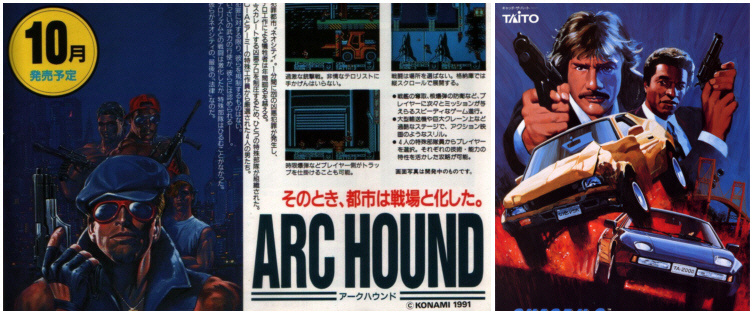
An advertisement showing
Arc Hound before it became Contra Force (left), Tony and Ray bust up crime
in their turbocharged Porsche (right)
Don't be left out! Be sure to follow The Retrogaming Times on Facebook or The Retrogaming Times Info Club on Twitter for a new retrogaming trivia question every Friday!
We need your questions! If
you have a trivia question you would like to submit for possible inclusion
in the Weekly Retrogaming Trivia question pool, e-mail it to trt@classicplastic.net!
If you question is selected to be featured, you will be entered in our
year-end prize drawing!
|
When I was reading submitted articles in preparation for editing and inclusion into this issue, I was surprised to see Mateus Fedozzi mention a review of Sega Classics Collection, which I wrote way back in 2005 for my personal gaming page. While far from the most amazing game ever made, my opinion on it now is the same as it was then, you could do a lot worse for twenty bucks. Seeing that review brought up by someone as a positive influence shows how important it is to give complete and unbiased opinions on games, no matter who you are, and no matter where you present them. In the grand scheme of video game journalism, at any level, I'm absolutely nobody. Yet whether I love, hate, or are indifferent toward a video game, I want to make sure I can talk through my opinion to give it reasoning and weight.
It's when someone can't explain why they enjoy or dislike a game that the massive gray area of review bias sets in. In part it's what tainted professional video game journalism, soiling it as a career built on shilling for corporate influence. These days it's all about social media, meaning anyone can potentially skew sales of a video game based on a knee-jerk reaction. I'm sure nearly everyone reading can think of a game that was positively or negatively affected in error due to fast reaction on social media. That's something to think about before ranting or raving about a game online in the future, myself included. Seeing that review referenced also reminded me that I plan on revisiting all the games I reviewed on that old page of mine. The freshly rewritten reviews would eventually be articles here as I wind down that other earlier project.
Thank you once again for reading The Retrogaming Times. We'll be back on November 1st with our next issue. Be sure to follow The Retrogaming Times on Facebook and join our community for the latest updates and information! Additionally The Retrogaming Times Info Club on Twitter features up-to-the-moment news and notifications for all things The Retrogaming Times! I sincerely hope you enjoyed this issue and that you will return to read the next issue and possibly submit an article yourself. Remember, this newsletter can only exist with your help. Simply send your articles directly to me at trt@classicplastic.net or check out the submission guidelines on the main page. Submit an article today and join a great retrogaming tradition!
See You Next Game!

Content and opinions on this
page are those of their respective writer(s)
Assembled and published
by David Lundin, Jr. on September 1st, 2018 at ClassicPlastic.net
© 2018 The Retrogaming
Times. All Related Copyrights and Trademarks Are Acknowledged.